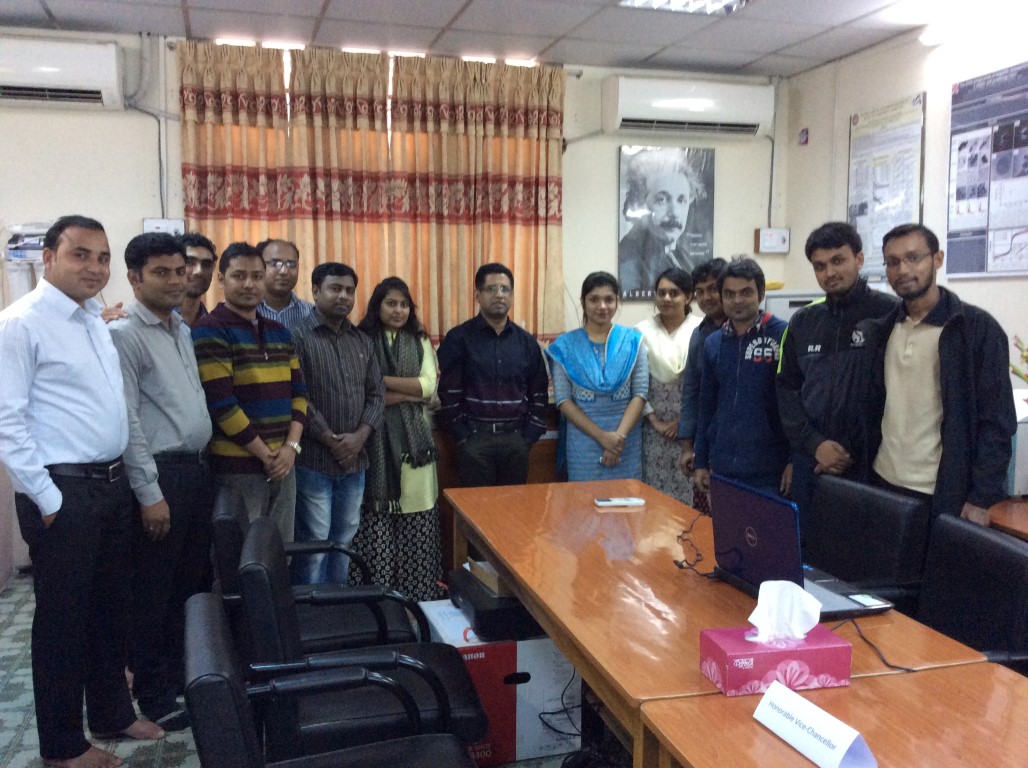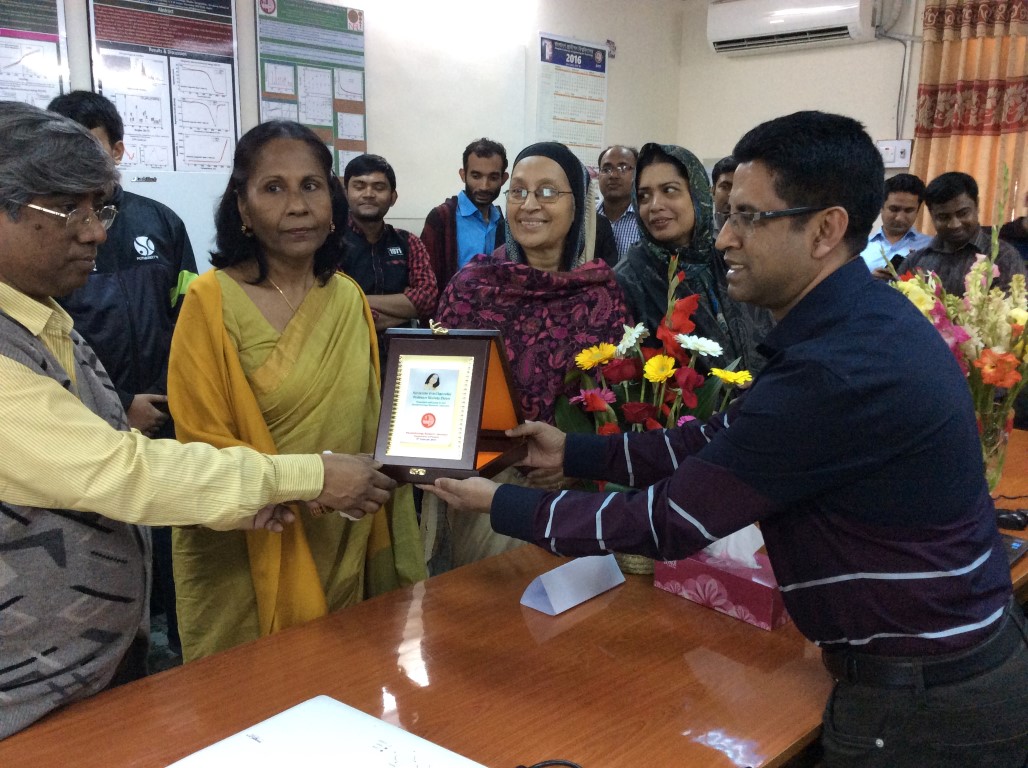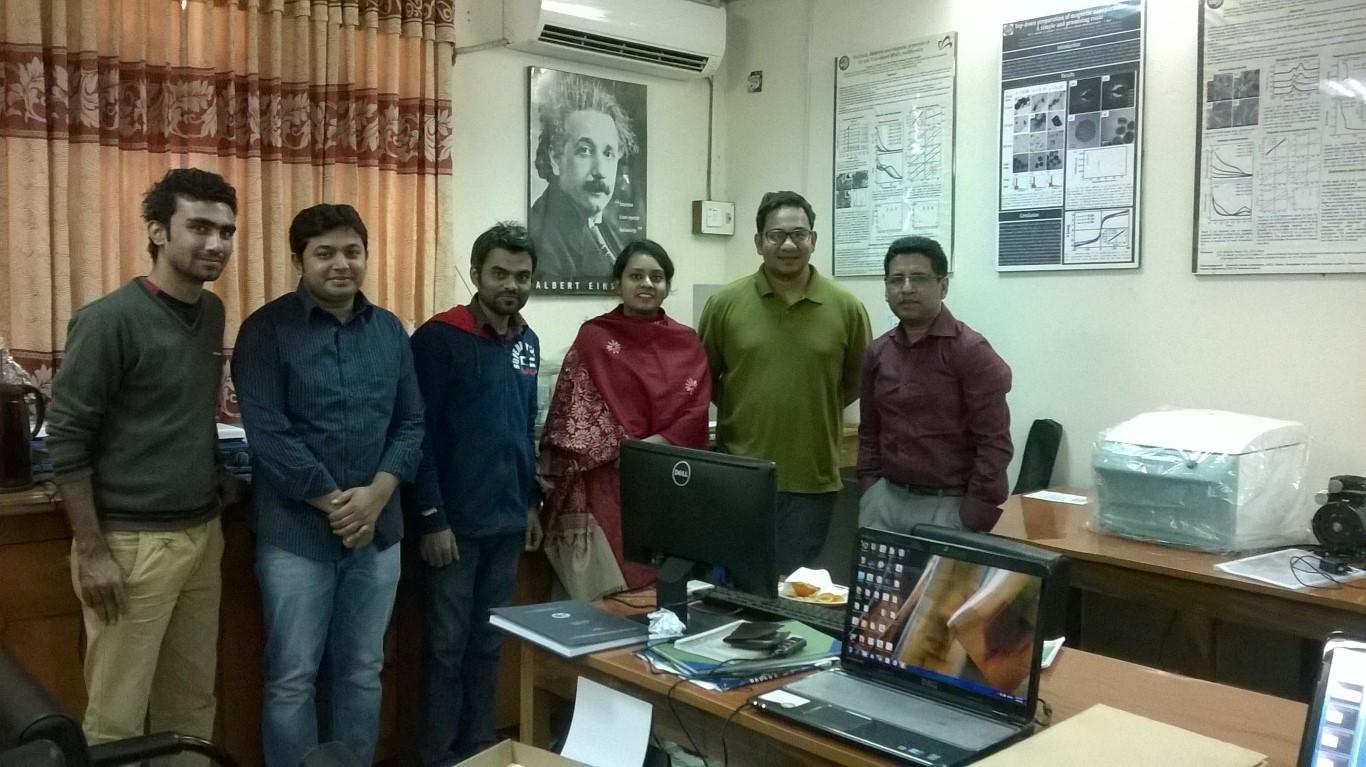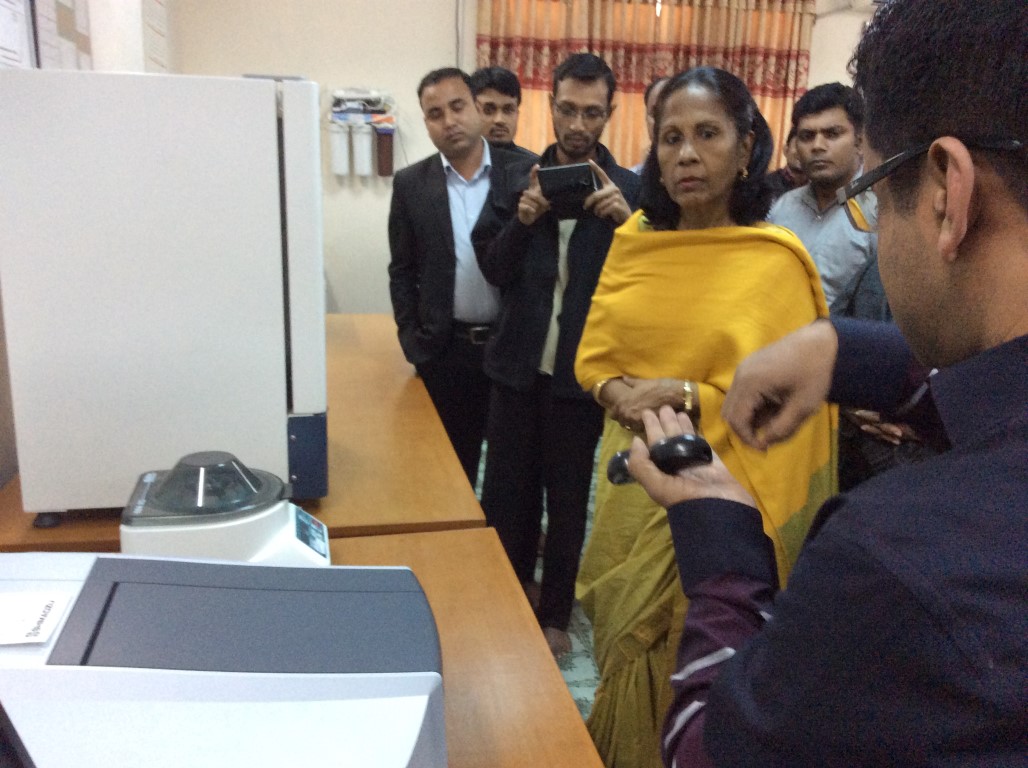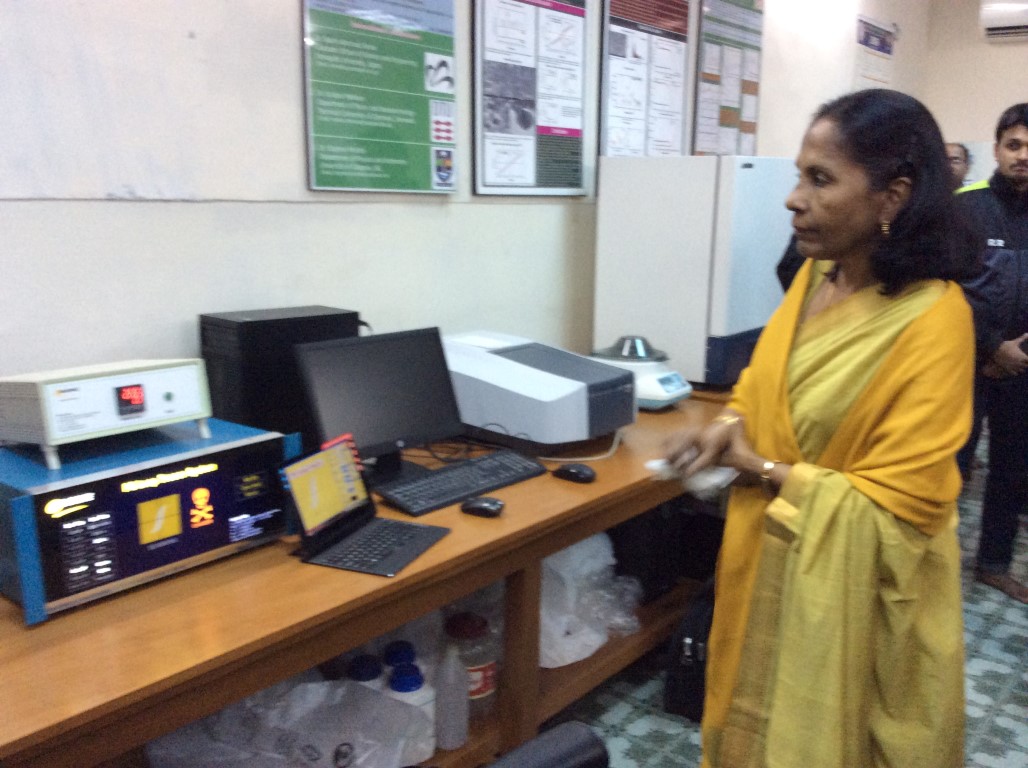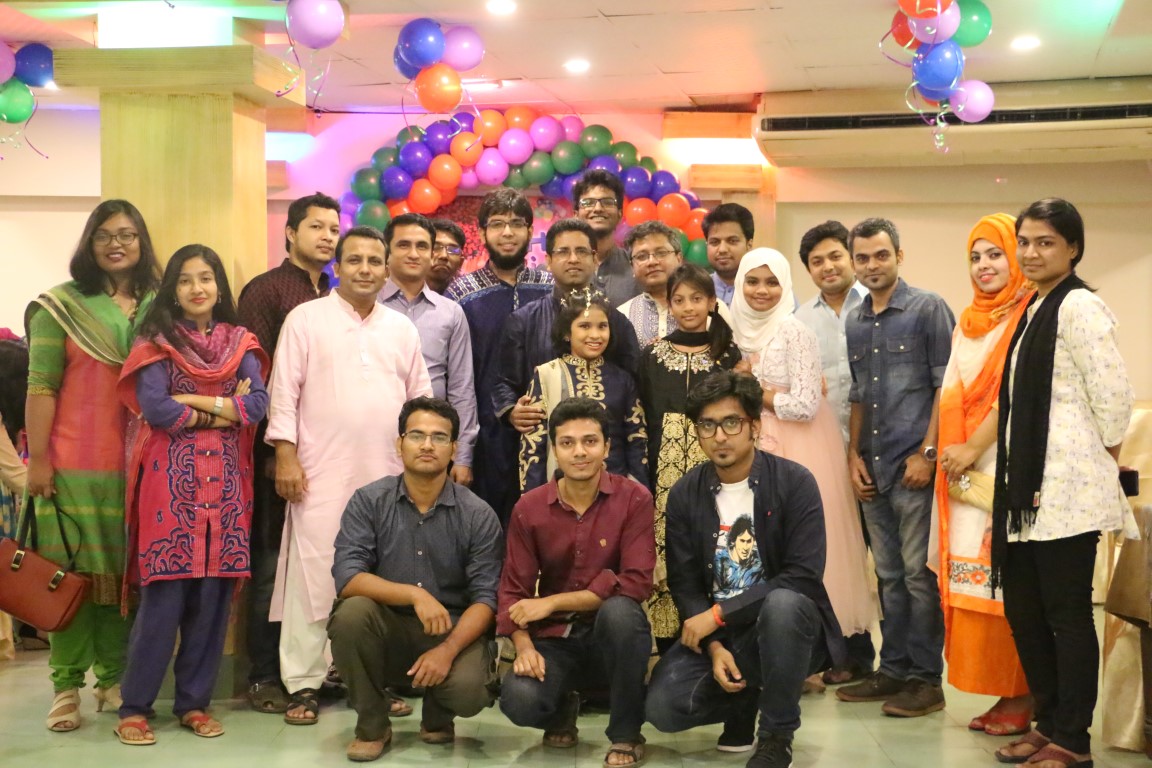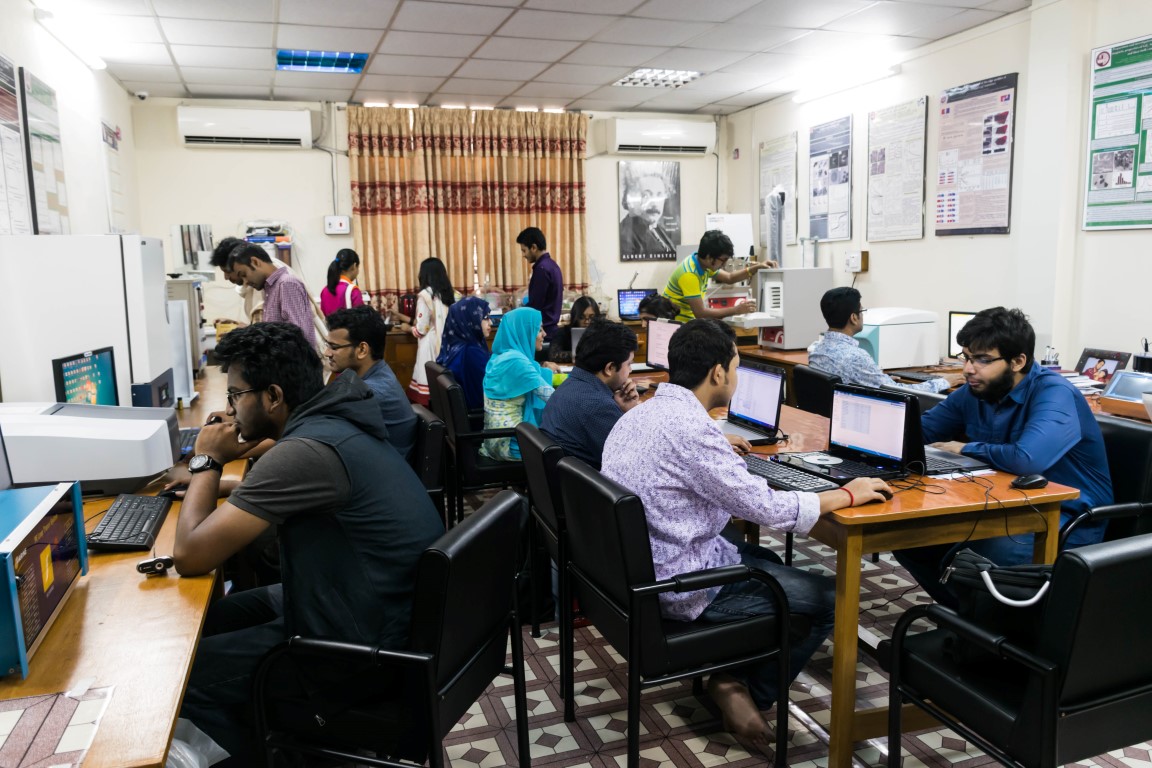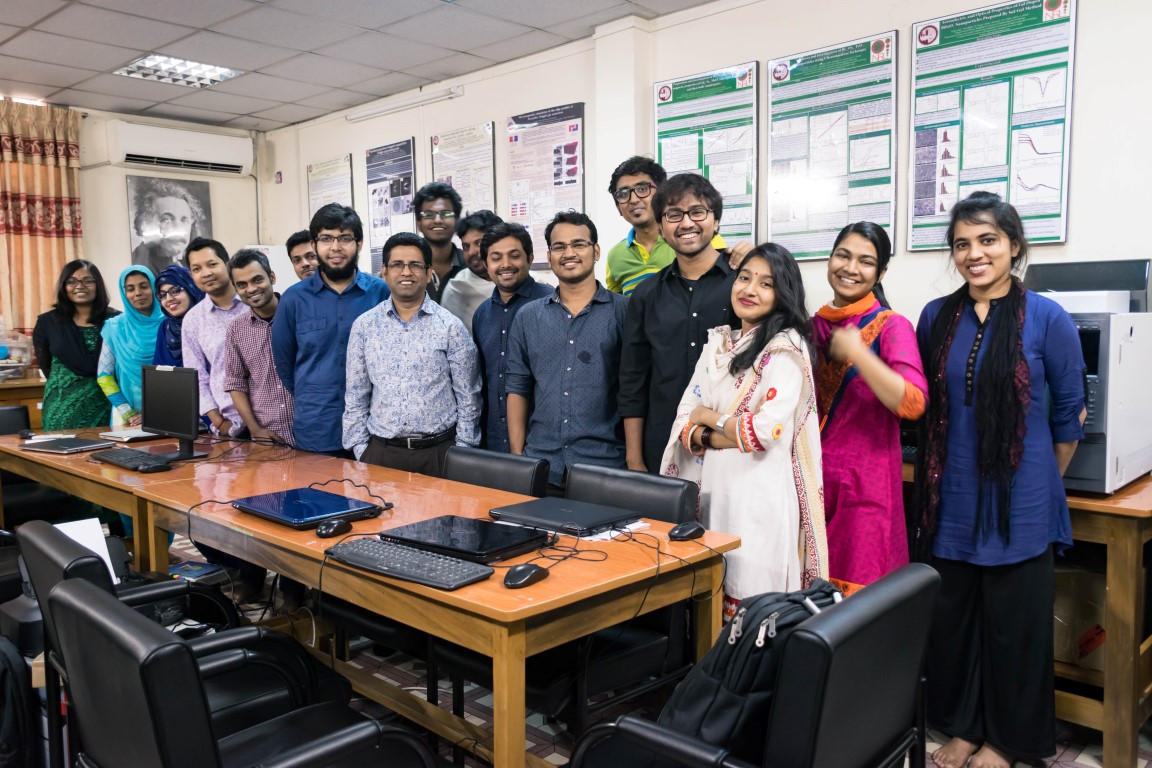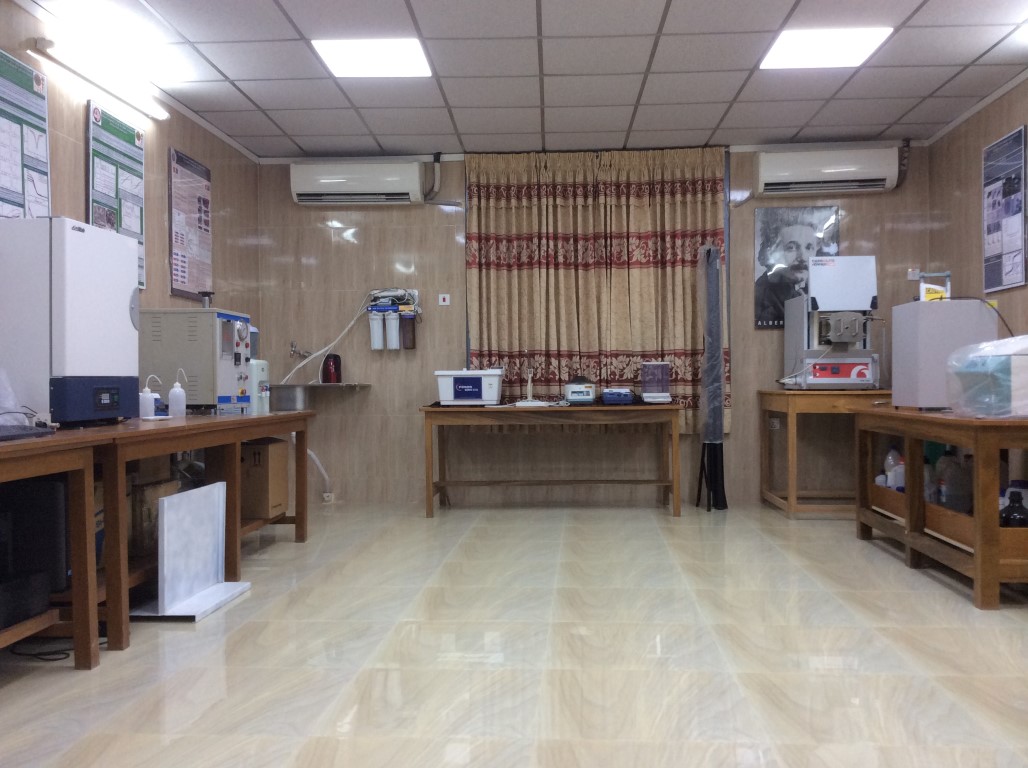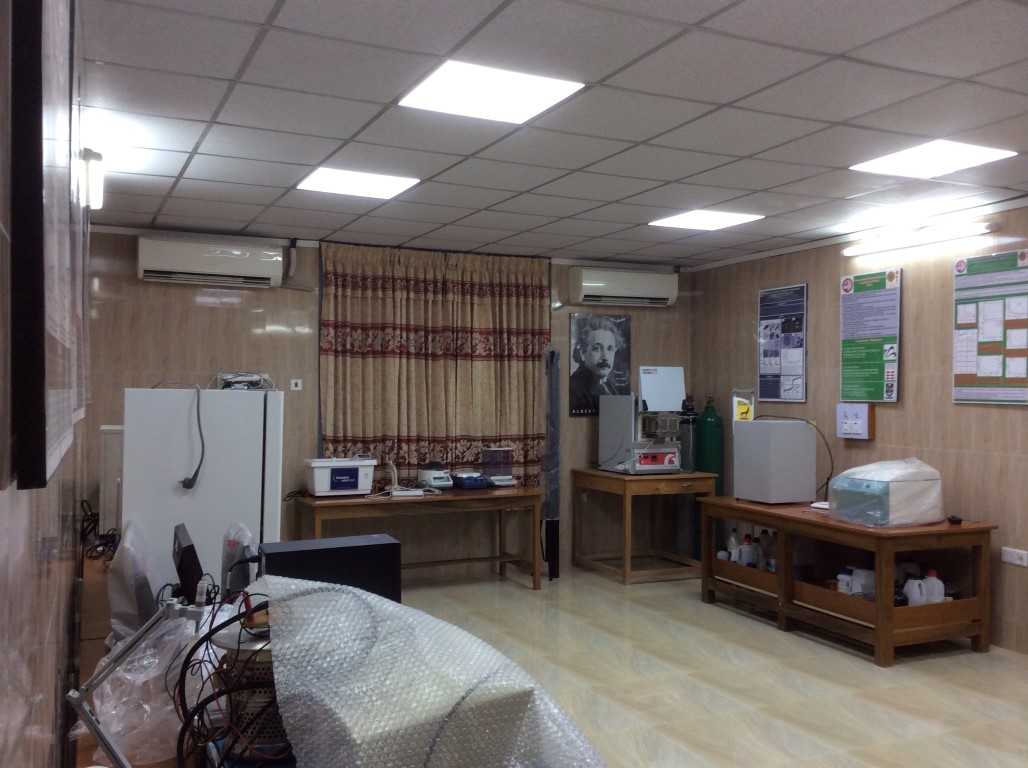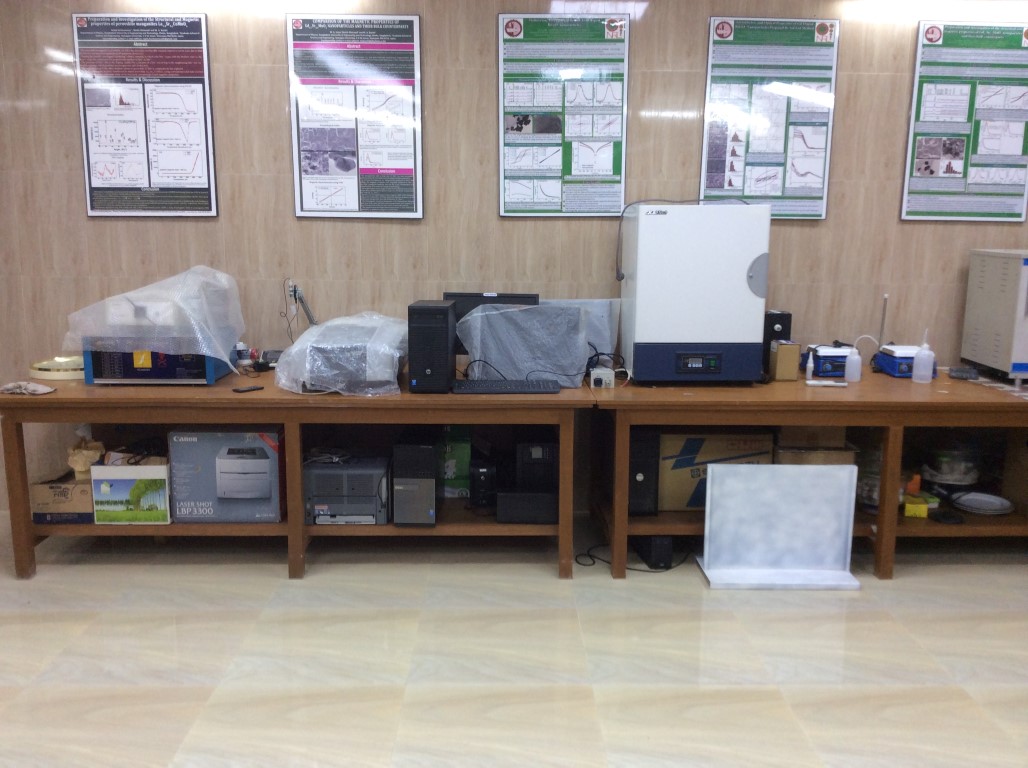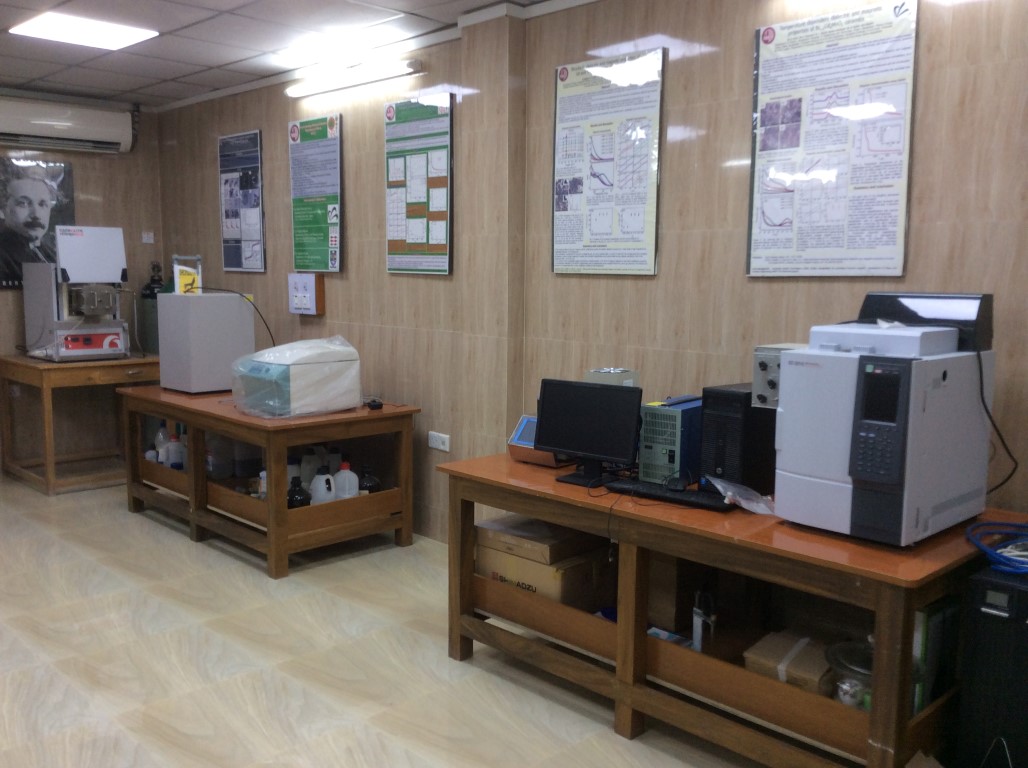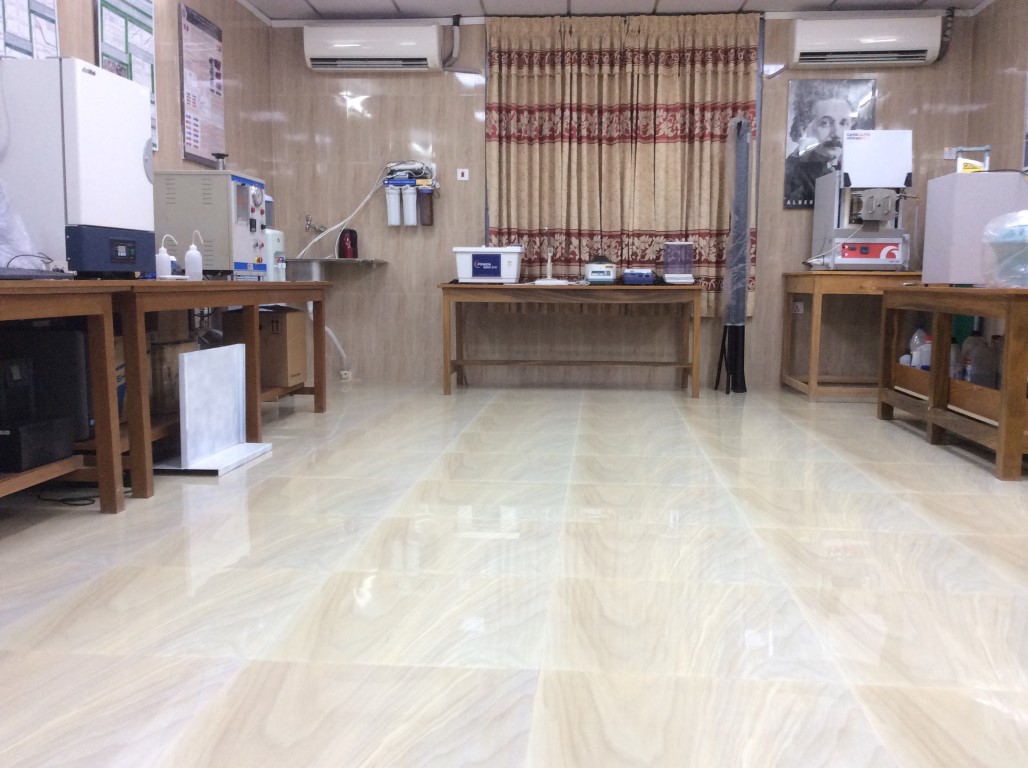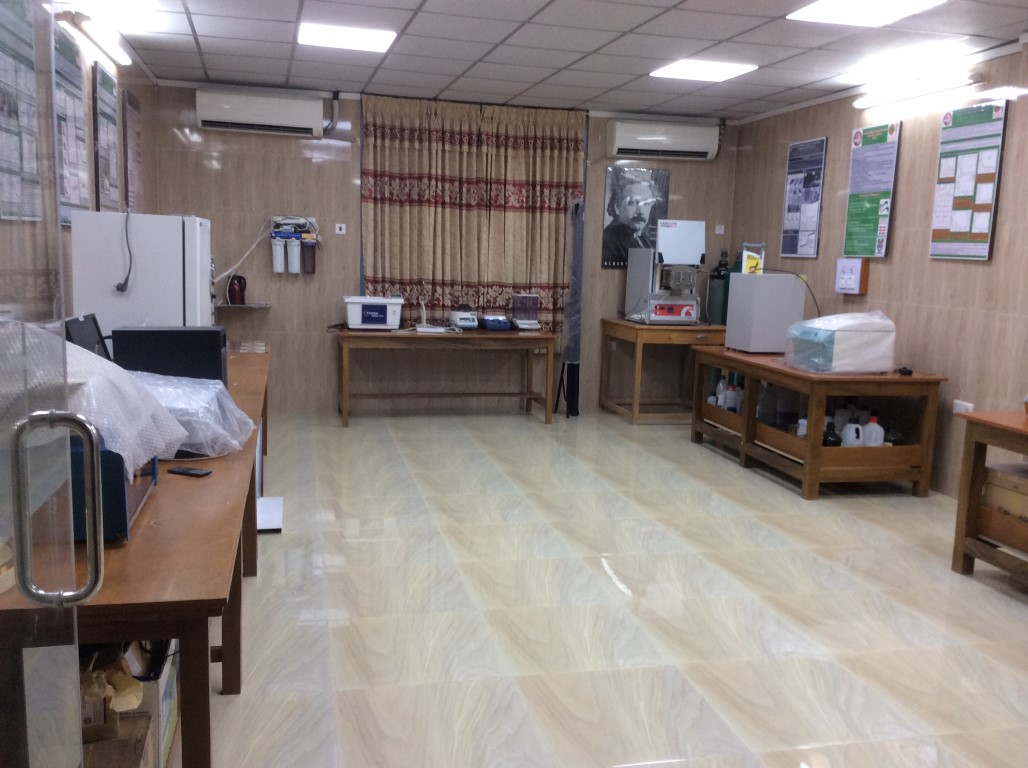

Bio
Dr. Mohammed Abdul Basith is serving as a Professor in the Department of Physics of Bangladesh University of Engineering and Technology (BUET), Dhaka. He has completed BSc Hons. and MSc degrees in Physics from Shahjalal University of Science and Technology, Sylhet. Dr. Basith achieved PhD degree from the Materials and Condensed Matter Physics group, University of Glasgow, UK in 2011. He is the Elected Fellow of the Institute of Physics (FInstP), and Royal Society of Chemistry (FRSC). His research interests include transmission electron microscopy (TEM) characterization of patterned ferromagnetic nanostructures by lithographic techniques. At present in BUET, Dr. Basith is working mainly on preparation and characterization of multifunctional nanomaterials for energy-related and spintronic applications. He has published more than 60 research articles in different prestigious journals like Nanoscale, Physical Review Applied, ACS Applied Materials & Interfaces, Journal of Materials Chemistry A, Journal of Materials Chemistry C, Nature Scientific Reports, Applied Physics Letters, Journal of Applied Physics, Physical Chemistry Chemical Physics, Nanotechnology, RSC Advances, Ceramics International, Journal of Alloys and Compounds etc. He is the reviewer of a number of reputed journals published from American Physical Society, American Institute of Physics, Royal Society of Chemistry etc. For the last few years, he has received research grants from different international and national organizations worth 500 thousand USD. In BUET, he has established Nanotechnology Research Laboratory for the synthesis and characterization of nanostructured materials. Since its inception in April 2014, he has been developing advanced facilities in this laboratory under different research projects from home and abroad. Dr. Basith designed a new syllabus titled `Nanophysics’ for the postgraduate students of BUET. The syllabus is designed to cover principles involved in fabrication of nanostructured systems and in measurement of phenomena at nanoscale. He is an activist of BUET career club to deliver lectures that helps young people build meaningful careers. Since 2019, he is serving the National Young Academy of Bangladesh (NYAB) as its first elected president and one of the founding members.
Education & Training
-
Ph. D. 2011
Materials and Condensed Matter Physics
University of Glasgow,UK
-
M.Phil. 2005
Solid State Physics
Bangladesh University of Engineering and Technology (BUET),Dhaka -1000, Bangladesh
-
M.Sc. 1998
Physics
Shah Jalal University of Sciences and Technology, Sylhet-3114, Bangladesh
-
B.Sc. 1997
Physics
Shah Jalal University of Sciences and Technology, Sylhet-3114, Bangladesh
Honors, Awards and Grants
-
SEP 2007 - MAR 2011Glasgow University funded postgraduate scholarship

UNIVERSITY OF GLASGOW, UK - [SEP 2007 - MAR 2011]
Glasgow University funded postgraduate scholarship
-
SEP 2007 - MAR 2011Overseas Research Student Award Scheme (ORSAS)

BRITISH GOVERNMENT - [SEP 2007 - MAR 2011]
Overseas Research Student Award Scheme (ORSAS) by British Government
-
JUL 2007Financial assistance provided for joining in the International colloquium on thin magnetic films and surfaces

BERLIN, GERMANY - [JUL 2007]
Financial assistance provided by the organizing committee for joining in the International colloquium on thin magnetic films and surfaces
-
JUL 2006Financial assistance for joining in the ICYS ICMR Summer School 2006 on Nanomaterials, National Institute of Materials Science, Tsukuba, JAPAN

ICYS-ICMR And UNIVERSITY OF CALIFORNIA, SANTA BARBABA, USA -
[JUL 2006]
Financial assistance for joining in the ICYS ICMR Summer School 2006 on Nanomaterials,
National Institute of Materials Science, Tsukuba, JAPAN. The nance was provided by the International Centre for Materials Research, University of California, Santa Barbara, USA -
JAN 2006Financial assistance from ICTP, Italy

ICTP, ITALY - [JAN 2006]
Financial assistance from ICTP, Italy for joining in the Advanced workshop on Recent Developments in Inorganic Materials, The Abdus Salam International Center for Theoretical Physics(ICTP), Trieste, ITALY. -
DEC 2006Financial assistance for joining in the JNCASR-ICMR Winter School on the Chemistry of Materials, JNCASR, Bangalore, INDIA

JNCASR, BANGALORE, INDIA And UNIVERSITY OF CALIFORNIA, SANTA
BARBARA, USA - [DEC 2006]
Financial assistance for joining in the JNCASR-ICMR Winter School on the Chemistry of Materials, JNCASR, Bangalore, INDIA. The nance was provided by the International Centre for Materials Research, University of California, Santa Barbara, USA. -
AUG 2006Financial assistance from ICTP, Italy

ICTP-NCNST-ICTS, CHINA - [AUG 2006]
Financial assistance from ICTP, Italy for joining in the ICTP-NCNST-ICTS Asian /Pacifi c Regional College on Science at the Nanoscale, Beijing, CHINA. -
AUG 2006NST fellowship

MINISTRY OF SCIENCE AND ICT, GOVT. OF BANGLADESH - [AUG 2006]
NST fellowship, Ministry of Science and ICT, Government of Bangladesh -
APR 2007Japanese Government Monbu-Kagakusho Scholarship

KEIO UNIVERSITY, JAPAN - [APR 2007]
Selected for Japanese Government Monbu-Kagakusho Scholarship for PhD programme -
APR 2007Taiwan International Graduate Scholarship

NATIONAL TAIWAN UNIVERSITY, TAIWAN - [APR 2007]
Selected for Taiwan International Graduate Scholarship for PhD programme
-
APR 2005Japanese Government Monbu-Kagakusho Scholarship

EHIME UNIVERSITY, JAPAN - [APR 2005]
Selected for Japanese Government Monbu-Kagakusho Scholarship for PhD programme at Ehime University, Japan -
APR 2004State Educational Fund for M.Sc programme

NORWEGIAN UNIVERSITY OF SCIENCE AND TECHNOLOGY, NORWAY -
[APR 2004]
Selected for State Educational Fund for M.Sc programme from Norwegian University of Science and Technology, Norway.
Publications
Filter by type:
Sort by year:
Insights into the electronic structure, optical properties, and photocatalytic potential of Gd2CoCrO6 perovskite: a comprehensive theoretical and experimental investigation
Journal Paper Nanoscale Adv.,7, 1742-1753, 2025.
Abstract
In this study, we present a comprehensive theoretical and experimental investigation into the electronic structure, optical properties, and photocatalytic potential of Gd2CoCrO6 (GCCO) double perovskite. Using first-principles calculations with the generalized-gradient-approximation plus Hubbard U (GGA + U) method, we explored the effects of Coulomb interactions on the electronic properties. Our calculations revealed that GCCO exhibits a half-metallic nature, displaying metallic behavior for up-spin and semiconducting behavior for down-spin states. The optimized Ueff value of 4.2 eV accurately reproduces the direct bandgap of 2.25 eV, which aligns closely with experimental results obtained through UV-visible absorption spectroscopy and photoluminescence analysis. Additionally, time-resolved photoluminescence (TRPL) measurements indicate a mean charge carrier lifetime of 2.37 ns, suggesting effective charge separation. Mott–Schottky analysis and valence band X-ray photoelectron spectroscopy (XPS) confirm the n-type semiconducting nature of GCCO with favorable band edge positions for redox reactions. The combination of theoretical insights and experimental characterization indicates that GCCO holds significant promise as a photocatalyst for applications in renewable energy production and environmental remediation, particularly in solar-driven water splitting and pollutant degradation. Our study provides crucial insights into the electronic structure and optical properties of double perovskites like GCCO, highlighting their suitability for photocatalytic applications. Furthermore, the research paves the way for future work in the compositional engineering and defect modulation of double perovskites to optimize their photocatalytic efficiency.
Observation of Griffiths-like phase and magnetocaloric effect in disordered Y2CoCrO6 double perovskite
Journal Paper Mater. Adv., 6, 1379-1391, 2025.
Abstract
The increasing demand for advanced materials with multifunctional magnetic properties has sparked growing interest in rare-earth and transition metal-based double perovskites. In this study, we comprehensively investigate disordered Y2CoCrO6 (YCCO), synthesized via the sol–gel method. Structural analysis confirms a single-phase orthorhombic crystal structure with B-site disorder, as revealed by X-ray photoelectron spectroscopy, which also identifies mixed valence states of Co and Cr due to antisite disorder and oxygen vacancies. This structural disorder profoundly impacts YCCO′s magnetic properties, leading to the emergence of a Griffiths-like phase, detected through inverse susceptibility measurements. Additionally, the material exhibits both antiferromagnetic and weak ferromagnetic behaviors, evidenced by a negative Curie–Weiss temperature and unsaturated magnetic hysteresis loops. Arrott plot analysis indicates a second-order phase transition and magnetocaloric measurements reveal a maximum entropy change (Smax) of 0.217 J kg−1 K−1, a relative cooling power (RCP) of 17.36 J kg−1, and a temperature averaged entropy change (TEC) of 0.17 J kg−1 K−1 over a temperature span (Tlift) of 30 K under a 5 T field, showcasing its potential for low-temperature and multistage cooling applications. Although its modest magnetocaloric effect (MCE) performance is attributed to its antiferromagnetic nature with weak ferromagnetic contributions and a low Curie temperature, this work represents a significant step in unveiling the potential of YCCO for multifunctional applications. Future optimization through chemical doping, nanostructuring, and compositional modifications is proposed to enhance its magnetocaloric and functional properties, positioning YCCO as a strong candidate for advanced magnetic and cooling technologies.
Mechanistic insights into the enhanced photocatalytic efficiency of MoS2-tuned DyFeO3 heterojunction nanocomposites for pollutant degradation
Journal Paper Nanoscale,17, 6620-6636, 2025.
Abstract
In this study, DyFeO3–MoS2 heterojunction nanocomposites were synthesized by integrating porous DyFeO3 nanoparticles (an n-type semiconductor) with MoS2 nanosheets (a p-type semiconductor). The resulting p–n heterojunction substantially improved the photocatalytic efficiency for degrading methylene blue (MB) and levofloxacin (LFX). This design introduces a built-in electric field at the interface, promoting efficient charge separation and suppressing electron–hole recombination, thereby significantly enhancing photocatalytic performance under solar irradiation compared to DyFeO3 alone. Characterization studies, including XRD, FESEM, TEM, XPS, UV-visible absorbance, photoluminescence, and Mott–Schottky analysis, confirmed the nanocomposites’ crystalline structure, well-dispersed MoS2 nanosheets, oxygen vacancies, enhanced visible light absorption, and favorable band positions. The incorporation of MoS2 increased light absorption, enhanced charge separation, and improved surface area by mitigating DyFeO3 aggregation, leading to significantly higher photocatalytic degradation rates. Among the tested compositions, the DyFeO3–MoS2 (80 : 20) nanocomposite, containing 20 wt% MoS2, exhibited the highest efficiencies, with 96.5% degradation for MB and 88.7% for LFX. Further analyses, including activation energy determination, quantum yield measurement, scavenger tests, and reusability assessments, confirmed the optimized nanocomposite's performance and durability. The reduced activation energies and high quantum yields (35.5% for MB, 25.8% for LFX) indicate efficient photon conversion and radical generation, with superoxide radicals (˙O2−) identified as the primary reactive species. Stability tests revealed over 85% retention of activity after four cycles, underscoring the composite's robustness. Moreover, the photocatalytic mechanism revealed key insights into the degradation pathways of pollutants. This investigation demonstrates a viable solar-driven solution for efficient pollutant degradation in wastewater treatment by incorporating MoS2 into porous DyFeO3 nanostructures.
High-voltage symmetric supercapacitors developed by engineering DyFeO3 electrodes and aqueous electrolytes
Journal Paper J. Mater. Chem. A,13, 499-516, 2025.
Abstract
Aqueous supercapacitors (SCs) are often constrained by low operational voltage and energy density due to the low decomposition voltage of water. In this work, we address these limitations by fabricating symmetric SCs using nanoporous dysprosium orthoferrite (DyFeO3) electrodes in dilute, neutral aqueous electrolytes. The nanoporous architecture of the DyFeO3 electrode material, with an average pore size of 3.41 nm, was confirmed using Brunauer–Emmett–Teller analysis and comprehensively characterized through XRD, FESEM, TEM, XPS, Raman spectroscopy, EPR, and zeta potential measurements. The fabricated SC, operating in a 0.5 M Na2SO4 aqueous electrolyte, exhibited a high working voltage of 2.5 V, delivering an energy density of 41.81 W h kg−1 at a power density of 1250 W kg−1, with 90% capacitance retention after 10 000 cycles. Furthermore, the addition of 20% acetonitrile (AN) to the 0.5 M Na2SO4 electrolyte extended the potential window to 3.1 V, increasing the energy density to 84.43 W h kg−1 at a power density of 1550 W kg−1. The fabricated symmetric SC demonstrated excellent long-term stability, retaining approximately 99% capacitance and Coulombic efficiency after a 600 hours float voltage test. These findings, for the first time, reveal the potential of nanoporous DyFeO3 as electrode material in a 0.5 M Na2SO4(aq.)/20%AN electrolyte for advancing symmetric SCs, featuring an unprecedented ultra-wide electrochemical stability window along with significantly enhanced energy and power densities.
Dysprosium chromite nanoparticles: A promising photocatalyst for the remediation of ciprofloxacin and methylene blue from wastewater
Journal Paper j. jallcom.177295,2024.
Abstract
A facile sol-gel synthesis method was employed to synthesize dysprosium chromite (DyCrO3) nanoparticles (NPs), which were subsequently calcined at 750 ∘C to investigate their structural, optical, and photocatalytic properties. Rietveld refinement of powder X-ray diffraction patterns revealed a single-phase orthorhombic structure for the DyCrO3 NPs, exhibiting good crystallinity and belonging to the Pbnm space group. Furthermore, Field Emission Scanning Electron Microscopy and Transmission Electron Microscopy imaging revealed a promising morphology with an average particle size of 30 ± 7 nm. Optical assessments indicated an energy band gap of 2.72 eV, suggesting potential for solar light harvesting as a photocatalyst. Mott-Schottky plots confirmed the n-type semiconductor behavior of the DyCrO3 NPs, and valence band X-ray photoelectron spectroscopy analysis supported these findings. Electronic band structure calculations showed a substantial conduction band minimum and a positive valence band maximum, essential for promoting oxygen reduction and oxidation reactions, respectively, which are crucial for photocatalytic activity. Moreover, the synthesized DyCrO3 NPs demonstrated significant potential as efficient photocatalysts, effectively decomposing the antibiotic ciprofloxacin (CIP) under solar light. Notably, the DyCrO3 NPs achieved 83 % degradation of CIP within 240 min of solar irradiation. Similarly, under identical conditions, the DyCrO3 NPs photocatalyst showed promise in degrading 70 % of the colored organic pollutant methylene blue (MB). Interestingly, during the first 120 min, the degradation of CIP was approximately 25 % greater than that of MB. The ability of DyCrO3 NPs to efficiently degrade both colored and colorless pollutants highlights the catalyst’s inherent photocatalytic nature, rather than merely relying on dye-sensitization effects. Furthermore, the presence of DyCrO3 NPs reduced the activation energy for CIP degradation from 31.657 kJ mol−1 K−1 to 20.846 kJ mol−1 K−1, providing additional evidence of their true catalytic efficacy. Apparent quantum yield values of 40 % for CIP and 35 % for MB degradation further illustrate their superior solar energy harvesting ability. A comprehensive mechanism was developed to explain the impressive photocatalytic performance of the synthesized NPs, highlighting their potential in degrading pharmaceutical antibiotics.
Nanostructured DyFeO3 photocatalyst: an authentic and effective approach for remediation of industrial and pharmaceutical wastewater
Journal Paper J. Mater. Chem. A, 12, 25475-25490, 2024.
Abstract
The persistent issue of water contamination by industrial dyes and pharmaceutical residues has created an urgent need for advanced photocatalytic materials to effectively address environmental remediation. Despite ongoing research, developing novel photocatalysts with ideal band structures, high quantum yields, and strong stability remains a considerable challenge. In this study, we report the synthesis and detailed characterization of nanostructured dysprosium orthoferrite (DyFeO3) nanoparticles, designed with a porous architecture featuring an average pore size of 3.41 nm and a surface area of 23.25 m2 g−1 to enhance photocatalytic efficiency under solar irradiation. Using Inverse Fast Fourier Transform (FFT) analysis on selected areas of TEM images, we gained deeper insights into the formation and internal structure of these nanoparticles. DyFeO3 nanoparticles exhibit a direct band gap of 2.1 eV, making them particularly effective for solar light absorption. Comprehensive spectroscopic analyses, including Mott–Schottky measurements and valence band XPS, confirmed their n-type semiconducting nature and revealed an electronic band structure that supports efficient oxygen reduction and oxidation reactions. Additionally, time-resolved photoluminescence spectroscopy demonstrated a charge carrier lifetime of 2.43 ns, indicating efficient separation and transport of photogenerated charge carriers. The photocatalytic performance of DyFeO3 was evaluated through degradation experiments using two model pollutants: Rhodamine B (RhB) and Levofloxacin (LFX). The nanoparticles successfully degraded both the colored RhB and the colorless LFX, eliminating concerns of dye sensitization. Furthermore, the presence of DyFeO3 significantly reduced the activation energy for RhB degradation from 55.87 kJ mol−1 K−1 to 34.58 kJ mol−1 K−1 and for LFX from 38.4 kJ mol−1 K−1 to 34.1 kJ mol−1 K−1, demonstrating its catalytic efficiency. With apparent quantum yield values of 28.94% for RhB and 32.83% for LFX, these nanoparticles demonstrate exceptional solar energy harvesting capabilities. The high degradation efficiency, quantum yield, and stability of the single-structured DyFeO3 nanoparticles highlight their potential for large-scale applications in photocatalytic and environmental remediation technologies.
Moisture-Stable CsSnBr2Cl Halide Perovskite: Electrochemical Insights in Aqueous Environments
Journal Paper ACS Appl. Mater. Interfaces, 16, 36, 47535–47550, 2024.
Abstract
In this investigation, moisture-stable CsSnBr2Cl nanoparticles were synthesized by incorporating Cl into CsSnBr3 halide perovskite using the hot injection method. Various analyses including XRD, XPS, UV–vis absorbance, photoluminescence, and Mott–Schottky have confirmed that the structural properties, chemical states, optical properties, and electronic band structure of CsSnBr2Cl nanoparticles remain intact even after 75 days of water immersion, thereby conclusively demonstrating their moisture stability. In a three-electrode system, the comparative electrochemical performance of pristine CsSnBr3 nanoparticles and moisture-stable Cl-incorporated CsSnBr2Cl nanoparticles was evaluated in various aqueous electrolytes, including HCl, Na2SO4, and KOH. The results indicate that the CsSnBr2Cl electrode material exhibits superior electrochemical properties, such as a larger integrated cyclic voltammetry (CV) area, a wider potential window, longer charge–discharge times, and lower impedance parameters compared to the pristine CsSnBr3 nanoparticles. The electrochemical performance of CsSnBr2Cl nanoparticles was evaluated for potential applications in batteries, supercapacitors, fuel cells, and water splitting, with a focus on reaction kinetics, charge storage mechanisms, and impedance parameters. The electrochemical properties of the nanoparticles were assessed using a three-electrode configuration across various 0.5 M aqueous electrolytes (HCl, Na2SO4, and KOH). In HCl, the nanoparticles demonstrated impressive charge storage capability, achieving a capacitance of 474 F g–1 at 1 A g–1, affirming their suitability for energy storage devices. In Na2SO4(aq.), the nanoparticles exhibited excellent stability for supercapacitors, operating up to 1.6 V without significant oxygen evolution. Notably, in KOH, they demonstrated potential as effective water-splitting electrodes. The practical applicability of the nanoparticles was evaluated using a symmetric two-electrode configuration with HCl and Na2SO4 electrolytes. The capacitance values were 117 F g–1 in HCl and 70 F g–1 in Na2SO4 at 1 A g–1. Notably, after 5000 GCD cycles in HCl(aq.), the nanoparticles retained 93% of their capacitance and maintained 91% Coulombic efficiency. They also demonstrated stable operation across a temperature range of 3 to 60 °C, achieving an energy density of 5.83 W h kg–1 at a power density of 600 W kg–1. This study emphasizes the considerable potential of CsSnBr2Cl nanoparticles in advancing electrochemical energy storage technologies and sets a solid foundation for future research and development in metal halide perovskites.
B-site disorder driven Griffiths-like phase and electrochemical behavior in Y2NiCrO6 double perovskite.
Abstract
In this investigation, nanoparticles of B-site disordered Y2NiCrO6 (YNCO) double perovskite were synthesized by the facile sol–gel method to evaluate their magnetic and electrochemical properties. Their crystallographic structure is monoclinic and the average size of the particles is 79
10% La-doped BiFeO3 nanoceramics: A promising magnetic catalyst to degrade pharmaceutical antibiotics
Journal Paper j. ceramint.,11.110, 2023.
Abstract
In this investigation, BiFeO3 (BFO) and 10% La-doped BiFeO3 (BLFO) nanoceramics were synthesized by a sol–gel method for the photocatalytic degradation of colorless antibiotics ciprofloxacin and levofloxacin under the irradiation of 500 W Hg-Xe lamp. A good agreement between the structural transitions from rhombohedral to orthorhombic phase was observed by the X-ray diffraction and the vibrational modes in the Raman spectra, due to the substitution of Bi by La. Moreover, La doping resulted in a decrease in the particle size from ∼117 to 32 nm, reduction of oxygen vacancies, significant enhancement of magnetization, dramatic improvement of optical absorption, and reduction of band gap from 2.19 to 2.14 eV. The significantly enhanced magnetization might be associated with the suppression of the spiral spin cycloid of BFO due to the substitution of La and reduced size of the BLFO nanoceramics to ∼32 nm which was also confirmed by transmission electron microscopy imaging. The strong optical absorption of BLFO nanoceramics boosted their photo-generated charge carriers separation, produced more reactive species, and demonstrated ∼70% photocatalytic efficiency to degrade pharmaceutical pollutants from aqueous solution. The high saturation magnetization and strong optical absorption mostly in the visible region suggest the potentiality of BLFO nanoceramics as a promising photocatalyst with a superior recyclability to be magnetically extracted from the reaction medium.
Tuning the morphology, stability and optical properties of CsSnBr3 nanocrystals through bismuth doping for visible-light-driven applications
Journal Paper Nanoscale Advances
Abstract
In this investigation, we have demonstrated the synthesis of lead-free CsSnBr3 (CSB) and 5 mol% bismuth (Bi) doped CSB (CSB′ B) nanocrystals, with a stable cubic perovskite structure following a facile hot injection technique. The Bi substitution in CSB was found to play a vital role in reducing the size of the nanocrystals significantly, from 316 ± 93 to 87 ± 22 nm. Additionally, Bi doping has inhibited the oxidation of Sn2+ of CSB perovskite. A reduction in the optical band gap from 1.89 to 1.73 eV was observed for CSB′ B and the PL intensity was quenched due to the introduction of the Bi3+ dopant. To demonstrate one of the visiblelight-driven applications of the nanocrystals, photodegradation experiments were carried out as a test case. Interestingly, under UV-vis irradiation, the degradation efficiency of CSB′ B was roughly one order lower than that of P25 titania nanoparticles; however, it was almost five times higher when driven by visible light under identical conditions. The water stability of CSB′ B perovskite and suppression of the oxidative degradation of Sn were confirmed through XRD and XPS analyses after photocatalysis. Moreover, by employing experimental parameters, DFT-based first-principles calculations were performed, which demonstrated an excellent qualitative agreement between experimental and theoretical outcomes. The assynthesized Bi-doped CSB might be a stable halide perovskite with potential in visible-light-driven applications
MoS2 mediated tuning of CuCo2S4–MoS2 nanocomposites for high-performance symmetric hybrid supercapacitors
Journal Paper Journal of Materials Chemistry C
Abstract
In this investigation, molybdenum disulfide (MoS2) nanosheets, copper cobalt sulfide (CuCo2S4) nanomaterials, and MoS2 incorporated CuCo2S4–MoS2 nanocomposites were synthesized as electrode materials for hybrid supercapacitors. The concentrations of MoS2 were varied and optimized for the synthesis of CuCo2S4–MoS2 nanocomposites to improve their electrochemical properties for use in high-performance energy storage devices. The successful formation of CuCo2S4–MoS2 nanocomposites was confirmed by powder XRD analysis, TEM imaging and X-ray photoelectron spectroscopy analyses. In a three-electrode system, compared to other synthesized electrode materials, the CuCo2S4–MoS2 (80 : 20) nanocomposite with a 20 wt% concentration of MoS2 demonstrated the highest specific capacitance of 1333 F g1 at 1 A g1 current density and 94% capacitance retention after 5000 charge–discharge cycles. Notably, in a symmetric two-electrode configuration, the optimized CuCo2S4–MoS2 (80 : 20) nanocomposite also exhibited the highest specific capacitance of 670 F g1 at 1 A g1 current density and achieved an energy density of 33.5 W h kg1 at 600 W kg1 power density compared to that of other synthesized electrode materials. Finally, a prototype supercapacitor was assembled by utilizing the optimized CuCo2S4–MoS2 (80 : 20) nanocomposite as an electrode material via a coin cell to light up an LED. Our findings demonstrate that incorporation of MoS2 improves electrochemical performance and 20 wt% MoS2 is the optimum concentration to significantly enhance the charge storage capacity, conductivity, and stability of CuCo2S4. The charge storage mechanism of the optimized nanocomposite in a symmetric two-electrode system was comprehensively discussed. The outcome of this investigation demonstrated that the optimized CuCo2S4–MoS2 (80 : 20) nanocomposite with its high charge storage capacity, energy density, and excellent long-term stability can be used as an efficient electrode material for high-performance symmetric hybrid supercapacitors.
Structural, magnetic and optical properties of disordered double perovskite Gd2CoCrO6 nanoparticles
Journal Paper RSC Advances, 13, 17545, 2023
Abstract
We have synthesized disordered double perovskite Gd2CoCrO6 (GCCO) nanoparticles with an average particle size of 71 ± 3 nm by adopting a citrate sol–gel method to investigate their structural, magnetic, and optical properties. Rietveld refinement of the X-ray diffraction pattern showed that GCCO is crystallized in a monoclinic structure with space group P21/n, which is further confirmed by Raman spectroscopic analysis. The absence of perfect long-range ordering between Co and Cr ions is confirmed by the mixed valence states of Co and Cr. A Neel transition was observed at a higher ´ temperature of TN = 105 K compared to that of an analogous double perovskite Gd2FeCrO6 due to a greater degree of magnetocrystalline anisotropy of Co than Fe. Magnetization reversal (MR) behavior with a compensation temperature of Tcomp = 30 K was also observed. The hysteresis loop obtained at 5 K exhibited the presence of both ferromagnetic (FM) and antiferromagnetic (AFM) domains. Superexchange and Dzyaloshinskii–Moriya (DM) interactions between various cations via oxygen ligands are responsible for the observed FM or AFM ordering in the system. Furthermore, UV-visible and photoluminescence spectroscopy demonstrated the semiconducting nature of GCCO with a direct optical bandgap of 2.25 eV. The Mulliken electronegativity approach revealed the potential applicability of GCCO nanoparticles in photocatalytic H2 and O2 evolution from water. Due to a favorable bandgap and potentiality as a photocatalyst, GCCO can be a promising new member of double perovskite materials for photocatalytic and related solar energy applications.
Sol-gel based synthesis to explore structure, magnetic and optical properties of double perovskite Y2FeCrO6 nanoparticles
Journal Paper J. Alloys Compd., 944, 169066, 2023.
Abstract
In this present investigation, nanoparticles of B-site disordered Y2FeCrO6 (YFCO) double perovskite have been successfully synthesized for the first time by optimizing synthesis steps and temperatures of facile sol-gel technique to investigate their structural, magnetic, and optical properties. The Rietveld refinement of the X-ray diffraction pattern of YFCO nanoparticles revealed a single-phase orthorhombic structure with pbnm space group. The average size of the nanoparticles is around 67 ± 15 nm determined by both field emission scanning electron microscopy and transmission electron microscopy imaging. The existence of mixed valence states of Fe and Cr ions was confirmed by X-ray photoelectron spectroscopy which is an indication of the absence of proper B site long range ordering. The temperature dependent magnetization curves demonstrated negative magnetization of this double perovskite material with compensation temperature at around 170 K. The field-dependent magnetic hysteresis loops exhibited the coexistence of weak ferromagnetic and antiferromagnetic domains in YFCO nanoparticles. The exchange bias effect was observed below Néel temperature which is tunable by a cooling magnetic field. The UV–visible spectroscopy ensured that YFCO nanoparticles have a direct band gap of ∼ 1.90 eV, which was further confirmed by steady-state photoluminescence spectroscopy. This B-site disordered YFCO might enhance interest on basic fundamental research on disordered rare-earth and transition metal-based perovskite systems and can be used for spintronics as well as photocatalytic applications because of its favorable magnetic and optical properties.
Comparison of the structure-property relationships between sillenite and perovskite phases of Bi0.9Dy0.1FeO3 nanostructures
Journal Paper New J. Chem, 47, 4707 – 4719, 2023
Abstract
We explored a comprehensive comparison of the structure–property relationships between sillenite and perovskite phases of Bi0.9Dy0.1FeO3 (BDFO) nanostructures synthesized by hydrothermal (HT) and sol–gel (SG) techniques. The role of sillenite/perovskite phases as well as oxygen vacancies in the magnetic and catalytic properties was analyzed and compared, which to our knowledge, is the first of its kind at the nanometer scale. XRD results revealed the formation of a sillenite dominating phase through the HT synthesis at 160 °C, whereas, the SG method resulted in perovskite bismuth ferrite after calcination at an elevated temperature of 600 °C. Both scanning and transmission electron microscopy imaging demonstrated a mixed nanopowder and rod-like morphology of the materials synthesized by the HT technique, however, semi-spherical particles with a particle size of B100 nm were produced via the SG technique. The XPS analysis revealed that the number of oxygen vacancies was higher in the HT-synthesized BDFO compared to that of the SG-synthesized BDFO. A sharp transition of the HT-synthesized BDFO materials was observed at 43 K, whereas, the SG-synthesized materials revealed a gradual increase in the magnetization with the decrement of temperature from 400 to 5 K without any phase transition. The HT-synthesized BDFO demonstrated a better photocatalytic performance to degrade rhodamine B and colorless antibiotic ciprofloxacin compared to the SG-synthesized BDFO photocatalyst. This comprehensive analysis of the phase-structure, morphology, chemical states, and oxygen vacancies of BDFO materials synthesized under the standard synthesis conditions of two commonly used synthesis techniques might be helpful for researchers to understand the physico-chemical properties of analogous nanostructures for desired applications.
Nanostructured DyCrO3-rGO for efficient photocatalytic dye degradation and hydrogen generation
Journal Paper Materials Letters, 318, 132159, 2022.
Abstract
Dysprosium chromite (DyCrO3) nanoparticles and dysprosium chromite-reduced graphene oxide (DyCrO3-rGO) nanocomposite were synthesized by using a hydrothermal technique. The rGO incorporated DyCrO3-rGO photocatalyst demonstrated up to 87% efficiency to degrade rhodamine B dye which is higher than those of DyCrO3 and commercial Degussa P25 titania nanoparticles. DyCrO3-rGO also generated approximately 3 times greater amounts of hydrogen via water splitting compared to that produced by the P25 titania nanoparticles. The outcome of this investigation might be helpful for synthesizing rGO-based nanocomposite heterostructures for superior solar energy-driven applications.
Effect of Gd and Y co-doping in BiVO4 photocatalyst for enhanced degradation of methylene blue dye
Journal Paper J. Alloys Compd., 895 (2), 162629, 2022
Abstract
The development of metal oxide photocatalysts with improved dye degradation efficiency under natural sunlight is in increasing demand due to their superior chemical stability and cost effectiveness. In this context, Gd and Y co-doped BiVO4 having the nominal compositions Bi0.92GdxYyVO4(0.06 ≤ x ≤ 0.08; 0 ≤ y ≤ 0.02) have been synthesized via a surfactant free hydrothermal technique. The structural characterizations by X-ray diffraction, Raman spectroscopy and Fourier transform infrared spectroscopy confirmed a monoclinic to tetragonal phase transition induced by co-doping in BiVO4. High resolution transmission electron microscopy images revealed successful synthesis of Gd and Y co-doped BiVO4 with a very good crystallinity. The steady-state photoluminescence spectroscopy analysis indicated significant suppression of charge carrier recombination in the co-doped samples. Under simulated sunlight, Bi0.92Gd0.07Y0.01VO4 photocatalyst demonstrated 94% degradation of methylene blue dye (MB) within 90 min of irradiation time, which is about 4 times higher than that of pristine BiVO4 photocatalyst. This superior photocatalytic performance may be attributed to the synergistic effect of nanorod like shape of the synthesized materials, negative surface charge, and enhanced charge career lifetime of the Bi0.92Gd0.07Y0.01VO4 photocatalyst.
Highly efficient photocatalytic degradation of hazardous industrial and pharmaceutical pollutants using gadolinium doped BiFeO3 nanoparticles
Journal Paper J. Alloys Compd., 901, 163604, 2022
Abstract
This investigation highlights the synthesis of an efficient photocatalyst, 10% gadolinium (Gd) doped BiFeO3 (BGFO), via a facile hydrothermal technique at a lower reaction temperature of 160 ∘C and its effective application towards the degradation of industrial effluents, such as rhodamine B (RhB), methylene blue (MB) and pharmaceutical pollutants such as ciprofloxacin (CIP), levofloxacin (LFX) under solar irradiation. The successful fabrication of the photocatalyst was confirmed by the Rietveld refined powder X-ray diffraction, Fourier transform infrared spectroscopy, and X-ray photoelectron spectroscopy analyses. The high-resolution transmission electron microscope imaging demonstrated the formation of nanoparticles with excellent morphology and very good crystallinity. The optical characterizations revealed a reduction in the optical bandgap from 1.95 to 1.18 eV, as well as effective suppression of electron-hole pair recombination in the BGFO sample. Notably, the photocatalyst BGFO demonstrated 96% and 97% degradation of RhB and MB within 240 and 180 min of solar irradiation, respectively. Moreover, the photodegradation of colorless organic contaminants CIP and LFX was also examined to evaluate the photosensitization properties. Interestingly, about 80% and 79% degradation of CIP and LFX was obtained within 240 min of solar irradiation. The enhanced photocatalytic activities of BGFO could be attributed to the excellent morphology, good crystallinity, increased optical absorption, and effective separation of the photogenerated charge carriers. Additionally, based on the band structures, a plausible mechanism was proposed to comprehend the rationale behind the influential photocatalytic performance of the synthesized nanoparticles to explore their potential towards the future of wastewater treatment on an industrial scale.
First-principles study on phase stability and physical properties of B-site ordered Nd2FeCrO6 double perovskite
Abstract
Here, the first-principles predictions on the structural stability, magnetic behavior and electronic structure of B-site ordered double perovskite Nd2CrFeO6 have been reported. Initially, the ground state of the parent single perovskites NdCrO3 and NdFeO3 have been studied to determine the relevant U value to investigate the properties of Nd2CrFeO6. The thermodynamic, mechanical, and dynamic stability analyses suggest the possibility of the synthesis of Nd2CrFeO6 double perovskite at ambient pressure. The compound shows ferrimagnetic (FiM) nature with 2 μB net magnetic moment and the magnetic ordering temperature has been estimated to be ~265 K. Electronic structure indicates higher probability of direct photon transition over the indirect transition with a band gap of ~1.85 eV. Additional effect of Nd (4f) spin and spin-orbit coupling (SOC) on the band edges have been found to be negligible for this 4f-3d-3d spin system. This first-principles investigation predicts that due to the FiM nature and significantly lower band gap compared to its antiferromagnetic (AFM) parent single perovskites, B-site ordered Nd2CrFeO6 double perovskite could be a promising material for sprintonic and visible-light driven energy device applications.
CuCo2S4-MoS2 nanocomposite: a novel electrode for high-performance supercapacitors †
Journal Paper J. Mater. Chem. C, 2022, dio:10.1039/D2TC01026G
Abstract
Ternary transition metal sulfides have emerged as promising electrode materials for next-generation supercapacitors because of their potential ability to simultaneously ensure high conductivity and stability during electrochemical reactions. In the present investigation, MoS2 incorporated CuCo2S4 nanocomposites have been successfully synthesized using a hydrothermal technique. The structural, morphological, elemental and chemical properties of the prepared CuCo2S4–MoS2 nanocomposite were investigated extensively. High resolution transmission electron microscopy imaging demonstrated the successful synthesis of CuCo2S4–MoS2 nanocomposites. The electrochemical capacitor performance of the nanocomposite has been evaluated both in three-electrode and symmetric two-electrode systems. In the three-electrode cell, a specific capacitance of 820 F g−1 was achieved for the CuCo2S4–MoS2 electrode at a current density of 0.5 A g−1 which is considerably higher than that of the CuCo2S4 electrode (249 F g−1). We observed that the charge storage capacity, conductivity and stability of CuCo2S4 improved significantly due to the incorporation of MoS2. Finally, an asymmetric supercapacitor was fabricated by assembling the CuCo2S4–MoS2 electrode with an activated carbon electrode which demonstrated a large stable working potential window of 1.6 V. Excellent long-term cyclic stability of 89% retention after 1000 galvanostatic charge-discharge cycles was evident. As a solid state device, it delivered a high energy density of 38.22 W h kg−1 at a power density of 400 W kg−1 and lit up one red LED for 170 s, indicating its superiority over the conventional Cu-Co based supercapacitors.
Structural, electrical, and magnetic properties of Ce and Fe doped SrTiO3
Abstract
Here, we report on the structural, vibrational phonon, electrical, and magnetic properties of undoped strontium titanate SrTiO3, Ce doped Sr1−xCexTiO3, and (Ce, Fe) co-doped Sr1−xCexTi1−yFeyO3 samples synthesized through solid state reaction route. The Rietveld refined powder x-ray diffraction analysis confirmed the cubic Pm-3m phase in our as-synthesized samples. We observed grain size reduction in SrTiO3 from scanning electron micrographs due to the incorporation of Ce and Fe dopants. The sample purity in terms of chemical species identification has been confirmed from energy-dispersive x-ray spectroscopy. The characteristic phonon modes in our samples are identified using room temperature Raman spectroscopy and benchmarked against existing relevant experimental observations. The incorporation of Ce and Fe as substitutional dopants in SrTiO3 unit cell was confirmed from the absence of absorption at 480, 555, 580, and 1635 cm−1 band in Fourier transform infrared spectra. The 3% Ce doping in Sr0.97Ce0.03TiO3 sample may have induced ferroelectric order, whereas the undoped SrTiO3 (STO) revealed lossy paraelectric nature. In the case of (Ce = 3%, Fe = 10%) co-doped Sr0.97Ce0.03Ti0.90Fe0.10O3 sample, we observed ferromagnetic hysteresis with orders of magnitude enhancement in remnant magnetization and coercivity as compared to undoped STO sample. This long range robust ferromagnetic order may have originated from F-center mediated magnetic interaction.
Simple Low Temperature Technique to Synthesize Sillenite Bismuth Ferrite with Promising Photocatalytic Performance
Journal Paper ACS Omega, 7, 39, 34901-34911, 2022.
Abstract
Sillenite-type members of the bismuth ferrite family have demonstrated outstanding potential as novel photocatalysts in environmental remediation such as organic pollutant degradation. This investigation has developed a low temperature one-step hydrothermal technique to fabricate sillenite bismuth ferrite Bi25FeO40 (S-BFO) via co-substitution of 10% Gd and 10% Cr in Bi and Fe sites of BiFeO3, respectively, by tuning hydrothermal reaction temperatures. Rietveld refined X-ray diffraction patterns of the as-synthesized powder materials revealed the formation of S-BFO at a reaction temperature of 120–160 °C. A further increase in the reaction temperature destroyed the desired sillenite structure. With the increase in the reaction temperature from 120 to 160 °C, the morphology of S-BFO gradually changed from irregular shape to spherical powder nanomaterials. The high-resolution TEM imaging demonstrated the polycrystalline nature of the S-BFO(160) nanopowders synthesized at 160 °C. The as-synthesized samples exhibited considerably high absorbance in the visible region of the solar spectrum, with the lowest band gap of 1.76 eV for the sample S-BFO(160). Interestingly, S-BFO(160) exhibited the highest photocatalytic performance under solar irradiation, toward the degradation of rhodamine B and methylene blue dyes owing to homogeneous phase distribution, regular powder-like morphology, lowest band gap, and quenching of electron–hole pair recombination. The photodegradation of a colorless organic pollutant (ciprofloxacin) was also examined to ensure that the degradation is photocatalytic and not dye-sensitized. In summary, Gd and Cr co-doping have proven to be a compelling energy-saving and low-cost approach for the formulation of sillenite-phase bismuth ferrite with promising photocatalytic activity.
Nanostructured LaFeO3-MoS2 for efficient photodegradation and photocatalytic hydrogen evolution
Journal Paper Materials Science and Engineering: B, 271, 115295, 2021
Abstract
Fabrication of heterogeneous photocatalysts has received increasing research interest due to their potential applications for the degradation of organic pollutants in wastewater and evolution of carbon-free hydrogen fuel via water splitting. Here, we report the photodegradation and photocatalytic hydrogen generation abilities of nanostructured LaFeO3-MoS2 photocatalyst synthesized by facile hydrothermal technique. Prior to conducting photocatalytic experiments, structural, morphological and optical properties of the nanocomposite were extensively investigated using X-ray diffraction analysis, field emission scanning electron microscopy and UV-visible spectroscopy, respectively. Nanostructured LaFeO3-MoS2 photodegraded ~96% of rhodamine B dye within only 150 minutes which is considerably higher than that of LaFeO3 and commercial Degussa P25 titania nanoparticles. The LaFeO3-MoS2 nanocomposite also exhibited significantly enhanced photocatalytic efficiency in the decomposition of a colorless probe pollutant, ciprofloxacin eliminating the possibility of the dye-sensitization effect. Moreover, LaFeO3-MoS2 demonstrated superior photocatalytic activity towards solar hydrogen evolution via water splitting. Considering the band structures and contribution of reactive species, a direct Z-scheme photocatalytic mechanism is proposed to rationalize the superior photocatalytic behavior of LaFeO3-MoS2 nanocomposite.
Photocatalytic water splitting ability of Fe/MgO-rGO nanocomposites towards hydrogen evolution
Abstract
Photocatalytic water splitting has greatly stimulated as an ideal technique for producing hydrogen (H2) fuel by employing two renewable sources, i.e., water and solar energy. Here, we have adopted a facile hydrothermal approach for the successful synthesis of reduced graphene oxide (rGO) incorporated Fe/MgO nanocomposites followed by thermal treatment at inert atmosphere to investigate their ability for photodegradation and photocatalytic hydrogen evolution via water splitting. Transmission Electron Microscopy images of Fe/ MgO-rGO nanocomposite ensured the distribution of Fe/MgO nanoparticles throughout rGO sheets. Notably, all rGO supported nanocomposites, especially the one, thermally treated at 500 oC at Argon (Ar) atmosphere has demonstrated significantly higher photocatalytic efficiency towards the photodegradation of a toxic textile dye, rhodamine B, than pristine MgO and commercially available Degussa P25 titania nanoparticles as well as other composites. Under solar irradiation, Fe/MgO-rGO (500) nanocomposite exhibited 86% degradation of rhodamine B dye and generated almost four times higher H2 via photocatalytic water splitting compared to commercially available P25 titania nanoparticles. This promising photocatalytic ability of the Fe/MgO-rGO(500) nanocomposite can be attributed to the improved morphological and surface features due to heat treatment at inert atmosphere as well as escalated charge carrier separation with increased light absorption capacity imputed to rGO incorporation.
Frequency and temperature dependent electric polarization, relaxation, and transport properties of Mo and W doped BaTiO3
Journal Paper Results in Physics, 30, 104873, 2021
Abstract
In this article, we report the structural, dielectric, electronic, and transport properties of Mo and W doped BaTiO3 ceramic. The BaTiO3 (BTO), BaTi0.85Mo0.15O3 (BTMO), and BaTi0.85W0.15O3 (BTWO) samples were prepared by double sintering ceramic technique. The X-ray diffraction patterns confirmed the tetragonal phase of the perovskite structure with the P4mm space group including some extra phases in BTMO and BTWO. A relaxation peak in the real part of electric modulus (M’’)is observed for BTO and BTMO at 3kHz. The dielectric constants, (εr' , εr'') and loss tangent (tanδ) for all samples were measured from 300 K to 450 K under the application of 100kHz electric field and temperature dependent dielectric anomalies ensure a ferroelectric (tetragonal) to paraelectric (cubic) phase transition in all samples. BTO and BTMO crystals display between normal ferroelectric and ideal relaxor behavior while BTWO crystal approaches to ideal relaxor ferroelectric behavior identified as canonical relaxor. Moreover, solid–liquid state anisotropy during the phase transition in all samples has been illustrated in terms of Fr ̈ohlich entropy. Apart from this, in BTO and BTWO samples, the conduction mechanism is highly dominated by the frequency of applied field compared to BTMO sample. Moreover, all studied samples exhibit semiconducting behavior with positive temperature coefficient of resistance (PTCR) effect in between 300 K and 450 K. The BTMO sample with maximum PTCR peak (2.9%/K at 415K) may find suitability for temperature controlled device application.
First-principles calculation of the electronic and optical properties of Gd2FeCrO6 double perovskite: Effect of Hubbard U parameter
Abstract
We have synthesized Gd2FeCrO6 (GFCO) double perovskite which crystallized in monoclinic structure with P21/n space group. The UV-visible and photoluminescence spectroscopic analyses confirmed its direct band gap semiconducting nature. Here, by employing experimentally obtained structural parameters in first-principles calculation, we have reported the spin-polarized electronic band structure, charge carrier effective masses, density of states, electronic charge density distribution and optical absorption property of this newly synthesized GFCO double perovskite. Moreover, the effects of on-site d-d Coulomb interaction energy (Ueff) on the electronic and optical properties were investigated by applying a range of Hubbard Ueff parameter from 0 to 6 eV to the Fe-3d and Cr-3d orbitals within the generalized gradient approximation (GGA) and GGA+U methods. Notably, when we applied Ueff in the range of 1 to 5 eV, both the up-spin and down-spin band structures were observed to be direct. The charge carrier effective masses were also found to enhance gradually from Ueff = 1 eV to 5 eV, however, these values were anomalous for Ueff = 0 and 6 eV. These results suggest that Ueff should be limited within the range of 1 to 5 eV to calculate the structural, electronic and optical properties of GFCO double perovskite. Finally we observed that considering Ueff = 3 eV, the theoretically calculated optical band gap ∼1.99 eV matched well with the experimentally obtained value ∼2.0 eV. The outcomes of our finding imply that the Ueff value of 3 eV most accurately localized the Fe-3d and Cr-3d orbitals of GFCO keeping the effect of self-interaction error from the other orbitals almost negligible. Therefore, we may recommend Ueff = 3 eV for first-principles calculation of the electronic and optical properties of GFCO double perovskite that might have potential in photocatalytic and related solar energy applications.
Lead-free CsSnCl3 perovskite nanocrystals: rapid synthesis, experimental characterization and DFT simulations
Abstract
Lead-free metal halide perovskites have attracted great attention as light harvesters due to their promising optoelectronic and photovoltaic properties. In this investigation, we have successfully synthesized thermally stable cubic phase cesium tin chloride (CsSnCl3) perovskite nanocrystals with improved surface morphology by adopting a rapid hot-injection technique. The excellent crystalline quality of these cubic shaped nanocrystals was confirmed by high-resolution transmission electron microscopy imaging. The binding of organic ligands on the surface of the sample was identified and characterized using nuclear magnetic resonance spectroscopy. UV-visible spectroscopy confirmed that the CsSnCl3 nanocrystals have a direct band gap of ∼2.98 eV, which was further confirmed using steady-state photoluminescence spectroscopy. The band edge positions calculated using the Mulliken electronegativity approach predicted the potential photocatalytic capability of the as-prepared nanocrystals, which was then experimentally corroborated through the photodegradation of rhodamine-B dye under both visible and UV-visible irradiation. Our theoretical calculations employing experimentally obtained structural parameters within the generalized gradient approximation (GGA) and GGA+U methods demonstrated a 90% accurate estimation of the experimentally observed optical band gap when Ueff = 6 eV was considered. The ratio of the effective mass of the hole and electron expressed as  was also calculated for Ueff = 6 eV. Based on this theoretical calculation and experimental observation of the photocatalytic performance of CsSnCl3 nanocrystals, we have proposed a rational interpretation of the “D” value. We think that a “D” value of either much smaller or much larger than 1 is an indication of the low recombination rate of the photogenerated electron–hole pairs and the high photocatalytic efficiency of the photocatalyst. We believe that this comprehensive investigation might be helpful for the large-scale synthesis of thermally stable cubic CsSnCl3 nanocrystals and also for a greater understanding of their potential in photocatalytic, photovoltaic and other prominent optoelectronic applications.
was also calculated for Ueff = 6 eV. Based on this theoretical calculation and experimental observation of the photocatalytic performance of CsSnCl3 nanocrystals, we have proposed a rational interpretation of the “D” value. We think that a “D” value of either much smaller or much larger than 1 is an indication of the low recombination rate of the photogenerated electron–hole pairs and the high photocatalytic efficiency of the photocatalyst. We believe that this comprehensive investigation might be helpful for the large-scale synthesis of thermally stable cubic CsSnCl3 nanocrystals and also for a greater understanding of their potential in photocatalytic, photovoltaic and other prominent optoelectronic applications.
Room temperature ferroic orders in Zr and (Zr, Ni) doped SrTiO3
Journal Paper Results in Physics, 31, 104940, 2021
Abstract
We synthesized strontium titanate SrTiO3 (STO), Zr doped Sr1−xZrxTiO3 and (Zr, Ni) co-doped Sr1−xZrxTi1−yNiyO3 samples using solid-state reaction technique to report their structural, electrical, and magnetic properties. The cubic Pm-3m phase of the synthesized samples has been confirmed using Rietveld analysis of the powder X-ray diffraction pattern. The grain size of the synthesized materials was reduced significantly due to Zr doping as well as (Zr, Ni) co-doping in STO. The chemical species of the samples were identified using energy-dispersive X-ray spectroscopy (EDX). The Zr and Ni dopants’ homogeneity were confirmed from EDX mapping to negate spurious ferroic order due to dopant segregation. We observed forbidden first-order Raman scattering at 148, 547 and 797 cm−1 which may indicate nominal loss of inversion symmetry in cubic STO. The absence of absorption at 500 cm−1 and within 600–700 cm−1 band in Fourier Transform Infrared spectra corroborates Zr and Ni as substitutional dopants in our samples. Due to 4% Zr doping in Sr0.96Zr0.04TiO3 sample dielectric constant, remnant electric polarization, remnant magnetization, and coercivity were increased. Notably, in the case of 4% Zr and 10% Ni co-doping we have observed clearly the existence of both FE and FM hysteresis loops in the Sr0.96Zr0.04Ti0.90Ni0.10O3 sample. In this co-doped sample, the remnant magnetization and coercivity were increased by ∼1 and ∼2 orders of magnitude respectively as compared to those of undoped STO. The coexistence of FE and FM orders in (Zr, Ni) co-doped STO might have the potential for interesting multiferroic applications.
Sol-gel synthesized double perovskite Gd2FeCrO6 nanoparticles: Structural, magnetic and optical properties
Journal Paper Journal of Alloys and Compounds, 878, 160389, 2021
Abstract
Lead-free double perovskites are overtaking single perovskites as solar harvesting materials due to their superior stability, excellent catalytic efficiency and minimal toxicity. In this investigation, we have synthesized double perovskite Gd2FeCrO6 (GFCO) nanoparticles for the first time via a facile sol-gel technique to investigate their structural, magnetic and optical properties. The double perovskite GFCO crystallized in monoclinic structure with P21/n space group. The Fe/Cr-O bond length was calculated as ~ 1.95 Å from the Raman spectrum which was consistent with the value, ~ 1.99 Å obtained from X-ray diffraction analysis. The average size of the nanoparticles was determined to be ~ 70 nm by both field emission scanning electron microscopy and transmission electron microscopy. The existence of mixed valence states of Fe and Cr was confirmed by X-ray photoelectron spectroscopy. The zero field cooled (ZFC) and field cooled (FC) curves largely diverged below 20 K. A downturn was observed in the ZFC curve at 15 K which corresponds to an antiferromagnetic, Néel transition. The narrow magnetic hysteresis loop recorded at 5 K was nearly saturated and demonstrated an asymmetric shift along the magnetic field axis indicating the concurrence of ferromagnetic and antiferromagnetic domains in GFCO nanoparticles. The UV–visible and photoluminescence spectroscopic analyses unveiled the semiconducting nature of nanostructured GFCO with an optical band gap of 2.0 eV. The as-synthesized thermally stable lead-free GFCO semiconductor might be a potential perovskite material to be employed in photocatalytic and related solar energy applications due to its ability to absorb the visible spectrum of the solar light.
Thermal stability of the crystallographic structure of nanocrystalline Nd0.7Sr0.3MnO3 manganite with enhanced magnetic properties
Journal Paper AIP Advances 10, 095135, 2020.
Abstract
We report the effect of temperature on the crystallographic structure and magnetic properties of ultrasonically prepared nanostructured Nd0.7Sr0.3MnO3 perovskite manganite. The crystal structure of as-synthesized nanoparticles remains unaltered over a wide scanning temperature range. Temperature dependent magnetization measurements demonstrate that the Curie temperature (Tc) of Nd0.7Sr0.3MnO3 nanoparticles is in the range of 211 K–220 K under largely varying applied magnetic fields. Below Tc, the soft ferromagnetic nature of these nanoparticles is confirmed by the field-dependent magnetization measurements. The absence of the charge-ordered state is also revealed in this nanomanganite down to 20 K, which is strikingly different from analogous Nd–Sr based nanocrystals. The experimentally observed effective paramagnetic moment and saturation magnetic moment have matched quite well with the values calculated theoretically. The Tc values up to a temperature of 220 K, nearly perfect ferromagnetically ordered Mn ions below Tc, high saturation magnetization, and magnetic softness of synthesized nanostructured Nd0.7Sr0.3MnO3 manganite can be associated with their good crystallinity as well as the nominal internal and surface disorder effect owing to intermediate particle size (∼75 nm to 150 nm). Our investigation elucidates the promising potential of nanocrystalline Nd0.7Sr0.3MnO3 particles for numerous technological applications.
Facile high-yield synthesis of MoS2 nanosheets with enhanced photocatalytic performance using ultrasound driven exfoliation technique
Journal Paper Materials Research Express, 6, 125079, 2019
Abstract
We have demonstrated a facile one-step ultrasound driven exfoliation technique for the synthesis of few-layer MoS2 nanosheets from bulk MoS2 powder with a yield of almost 60%. Structural, morphological and optical characterizations of non-ultrasonicated and ultrasonicated MoS2 are carried out in nominally identical conditions to make a direct comparison between their properties. The Rietveld refined powder X-ray diffraction patterns elucidate the semiconducting 2H phase of MoS2 nanosheets without any structural deformation caused by ultrasonication. Field emission scanning electron microscopy ensures the successful formation of ultrathin MoS2 nanosheets having thickness in the range of 8-15 nm. The ultrasonicated MoS2 nanosheets demonstrate considerably higher absorbance in the visible spectra compared to their non-ultrasonicated counterpart. A slight enhancement is observed in the optical indirect bandgap of exfoliated MoS2 nanosheets which is further confirmed by first-principles calculations. The photoluminescence spectroscopy reveals the enhanced potential of ultrasonicated MoS2 to suppress photogenerated carrier recombination phenomenon. The ultrasonicated MoS2 manifests considerably better performance in photocatalytic degradation of Rhodamine B (RhB) dye under visible light irradiation as compared to non-ultrasonicated MoS2. Further, addition of H2O2 in the solution has enabled ultrasonicated MoS2 nanosheets to photodegrade 100% of RhB dye within only 1 hour and 40 minutes. The outcome of our investigation suggests that this ultrasound-assisted exfoliation technique can be effectively employed as a rapid and efficient route for the large-scale synthesis of few-layer ultrathin MoS2 nanosheets with superior photocatalytic performance. The synthesized MoS2 nanosheets may further lead to engineering heterogeneous structures of different photocatalysts having promising potential for numerous applications.Enhanced Magnetic Softness of Double-Layered Perovskite Manganite La1.7Gd0.3SrMn2O7
Journal Paper IEEE Magnetics Letters, 10 (1), 2503704, 2019.
Abstract
Bulk polycrystalline samples of Gd-doped La2-xGdxLa2-xGdxSrMn2O7 (x = 0.3, 0.6) double-layered perovskite manganites were synthesized in air by conventional solid-state reaction and then annealed at 600 °C in inert (N 2 ) atmosphere. Rietveld refined powder X-ray diffraction patterns show impurity peaks for samples synthesized in air, whereas annealing completely removes the undesired peaks in the lightly doped (15% Gd) sample and partially removes them in the heavily doped (30% Gd) sample. The morphology was improved in both samples due to annealing. Magnetic hysteresis loops demonstrate enhanced magnetic softness for the lightly doped manganite. Its saturation magnetization at room temperature at 10 kOe is 50 emu/g, and is increased to 53 emu/g after heat treatment. Heat treatment also decreases its coercive field and remanent magnetization. These properties indicate that 15% Gd-doped La 1.7Gd0.3 SrMn2O7 manganite may be used in applications where magnetic softness is desired.MoS2 nanosheets incorporated α-Fe2O3/ZnO nanocomposite with enhanced photocatalytic dye degradation and hydrogen production ability
Journal Paper RSC Advances, 9, 40357–40367, 2019
Abstract
We have synthesized MoS2 incorporated α-Fe2O3/ZnO nanocomposites by adapting a facile hydrothermal synthesis process. The effect of incorporating ultrasonically exfoliated few-layer MoS2 nanosheets on the solar-light driven photocatalytic performance of α-Fe2O3/ZnO photocatalyst nanocomposites has been demonstrated. Structural, morphological and optical characteristics of the as-synthesized nanomaterials are comprehensively investigated and analyzed by performing Rietveld refinement of powder X-ray diffraction patterns, field emission scanning electron microscopy and UV-visible spectroscopy, respectively. The photoluminescence spectra of the as-prepared nanocomposites elucidate that the recombination of photogenerated electron–hole pairs is highly suppressed due to incorporation of MoS2 nanosheets. Notably, the ultrasonicated MoS2 incorporated α-Fe2O3/ZnO nanocomposite manifests 91% and 83% efficiency in degradation of rhodamine B dye and antibiotic ciprofloxacin respectively under solar illumination. Active species trapping experiments reveal that the hydroxyl (˙OH) radicals play a significant role in RhB degradation. Likewise the dye degradation efficiency, the amount of hydrogen produced by this nanocomposite via photocatalytic water splitting is also considerably higher as compared to both non-ultrasonicated MoS2 incorporated α-Fe2O3/ZnO and α-Fe2O3/ZnO nanocomposites as well as Degussa P25 titania nanoparticles. This indicates the promising potential of the incorporation of ultrasonicated MoS2 with α-Fe2O3/ZnO nanocomposites for the generation of carbon-free hydrogen by water splitting. The substantial increase in the photocatalytic efficiency of α-Fe2O3/ZnO after incorporation of ultrasonicated MoS2 can be attributed to its favorable band structure, large surface to volume ratio, effective segregation and migration of photogenerated electron–hole pairs at the interface of heterojunctions and the plethora of exposed active edge sites provided by the few-layer MoS2 nanosheets.From bulk to nano: A comparative investigation of structural, ferroelectric and magnetic properties of Sm and Ti co-doped BiFeO3 multiferroics
Journal Paper Materials Research Bulletin, 111, 93-101, 2019.
Abstract
In this investigation, multiferroic bulk ceramic materials with nominal compositions Bi1-xSmxFe1-yTiyO3 (x, y = 0.00, 0.03, 0.06) are synthesized by conventional solid-state reaction technique. Their corresponding nanoparticles are fabricated from these bulk powder materials using cost-effective ultrasonication method. Then, the structural and multiferroic properties of the synthesized nanoparticles and their bulk-counterparts are compared. The X-ray diffraction patterns of 6% Sm-Ti co-substituted BiFeO3nanoparticles as well as their bulk powder materials confirm rhombohedral to orthorhombic structural phase transition. Dynamic Light Scattering analysis (DLS) demonstrates the formation of particles with a size in the range of 10–100 nm for the 6% Sm-Ti co-substituted BiFeO3 sample. The fabricated nanoparticles of this particular composition also exhibit suppressed leakage current density and enhanced ferroelectric behavior. These nanoparticles also demonstrate improved ferromagnetic behavior compared to their bulk counterparts. Thus, the present investigation illustrates the impact of Sm and Ti as co-doping elements with 6% concentration in BiFeO3 nanoparticles with improved structural and multiferroic properties required for practical applications.
Low temperature synthesis of BiFeO3 nanoparticles with enhanced magnetization and promising photocatalytic performance in dye degradation and hydrogen evolution
Journal Paper RSC Advances , 8, 29613, 2018.
Abstract
Enhanced photocatalytic dye degradation and hydrogen production ability of Bi25FeO40-rGO nanocomposite and mechanism insight
Abstract
Sol-gel synthesis of DyCrO3 and 10% Fe-doped DyCrO3 nanoparticles with enhanced photocatalytic hydrogen production abilities
Abstract
Enhanced multiferroism in Gd-doped BiMn2O5 ceramics.
Journal Paper Ceramics International 44, 1594-1602, 2018
Abstract
Preparation of high crystalline nanoparticles of rare-earth based complex perovskites and comparison of their structural and magnetic properties with bulk counterparts
Abstract
A simple route to prepare Gd0.7Sr0.3MnO3 nanoparticles by ultrasonication of their bulk powder materials is presented in this article. For comparison, Gd0.7Sr0.3MnO3 nanoparticles are also prepared by ball milling. The prepared samples are characterized by x-ray diffraction (XRD), field emission scanning electron microscope (FESEM), energy dispersive x-ray (EDX), x-ray photoelectron spectroscope (XPS), and superconducting quantum interference device (SQUID) magnetometer. XRD Rietveld analysis is carried out extensively for the determination of crystallographic parameters and the amount of crystalline and amorphous phases. FESEM images demonstrate the formation of nanoparticles with average particle size in the range of 50–100 nm for both ultrasonication and 4 h (h) of ball milling. The bulk materials and nanoparticles synthesized by both ultrasonication and 4 h ball milling exhibit a paramagnetic to spin-glass transition. However, nanoparticles synthesized by 8 h and 12 h ball milling do not reveal any phase transition, rather show an upturn of magnetization at low temperature. The degradation of the magnetic properties in ball milled nanoparticles may be associated with amorphization of the nanoparticles due to ball milling particularly for milling time exceeding 8 h. This investigation demonstrates the potential of ultrasonication as a simple route to prepare high crystalline rare-earth based manganite nanoparticles with improved control compared to the traditional ball milling technique.
The 10% Gd and Ti co-doped BiFeO3: A promising multiferroic material
Abstract
In this investigation, undoped BiFeO3, Gd doped Bi0.9Gd0.1FeO3, and Gd-Ti co-doped Bi0.9Gd0.1Fe1-xTixO3 (x = 0.10, 0.20) materials were synthesized to report their multiferroic properties. The structural analysis and phase identification of these multiferroic ceramics were performed using Rietveld refinement. The Rietveld analysis has confirmed the high phase purity of the 10% Gd-Ti co-doped Bi0.9Gd0.1Fe0.9Ti0.1O3 sample compared to that of other compositions under investigation. The major phase of this particular composition is of rhombohedral R3c type structure (wt% >99%) with negligible amount of impurity phases. In terms of characterization, we address magnetic properties of this co-doped ceramic system by applying substantially higher magnetic fields than that applied in previously reported investigations. The dependence of temperature and maximum applied magnetic fields on their magnetization behavior have also been investigated. Additionally, the leakage current density has been measured to explore its effect on the ferroelectric properties of this multiferroic system. The outcome of this investigation suggests that the substitution of 10% Gd and Ti in place of Bi and Fe, respectively, in BiFeO3 significantly enhances its multiferroic properties. The improved properties of this specific composition is associated with homogeneous reduced grain size, significant suppression of impurity phases and reduction in leakage current density which is further asserted by polarization vs. electric field hysteresis loop measurements.
Effect of Strontium substitution on the structural and magnetic properties of La1.8Sr0.2MMnO6 (M = Ni, Co) layered manganites
Abstract
Sr-substituted perovskites, La1.8Sr0.2MMnO6 (M = Ni, Co), were synthesized using the solid-state reaction technique to present a systematic study on their morphological, structural and magnetic properties. The average grain size of the as-prepared La1.8Sr0.2MMnO6 samples are in the range of 0.2–0.7 µm and those for La1.8Sr0.2CoMnO6 manganites are 0.1–2.8 μm, which is significantly less than that of unsubstituted La2NiMnO6 (LNMO) and La2CoMnO6 (LCMO) manganites. The XPS analysis enlightened about phase purity, binding energy and oxygen vacancy of La1.8Sr0.2MMnO6 manganites. The Sr-substituted LNMO has revealed a sharp ferromagnetic to paramagnetic phase transition at 160 ± 2 K, which is about 120 K less than that of parent LNMO. The Sr-substituted LCMO exhibited such a transition at 220 ± 2 K, which is 8 K less than that of parent LCMO. The temperature-dependent magnetization measurements suggest that the effect of Sr on the transition temperature in LNMO is more significant than that of LCMO.
Dy doped BiFeO3: A bulk ceramic with improved multiferroic properties compared to nano counterparts
Abstract
The synthesis as well as structural, multiferroic and optical characterization of Dy doped BiFeO3 multiferroic ceramic are presented. Bulk polycrystalline Bi0.9Dy0.1FeO3 sample is synthesized by solid state reaction, while their nano counterparts are prepared using ultrasonic probe sonication technique. Significant improvement of phase purity in the as synthesized samples is observed after the doping of Dy both in bulk Bi0.9Dy0.1FeO3 sample and corresponding nanoparticles as evidenced from Rietveld refinement. Magnetization measurements using SQUID magnetometer exhibit enhanced magnetic properties for Dy doped bulk Bi0.9Dy0.1FeO3 ceramic compared to their nanostructured counterparts as well as undoped BiFeO3. Within the applied field range, saturation polarization is observed for Bi0.9Dy0.1FeO3 bulk ceramic only. As a result, intrinsic ferroelectric behavior is obtained just for this sample. Optical bandgap measurements reveal lower bandgap for Dy doped bulk Bi0.9Dy0.1FeO3 ceramic compared to that of corresponding nanoparticles and undoped BiFeO3. The outcome of this investigation demonstrates the potential of Dy as a doping element in BiFeO3 that provides a bulk ceramic material with improved multiferroic and optical properties compared to those of corresponding nanoparticles which involve rigorous synthesis procedure.
Simple sonofragmentation approach for synthesis of NiFe nanoalloy with tunable magnetization
Abstract
Temperature-dependent phase transition and comparative investigation on enhanced magnetic and optical properties between sillenite and perovskite bismuth ferrite-rGO nanocomposites
Abstract
Determination of optical band gap of powder form nanomaterials with improved accuracy
Journal Paper Journal of Nanophotonics 11(4), 046016 (2017).
Abstract
Saturation magnetization and band gap tuning in BiFeO3 nanoparticles via co-substitution of Gd and Mn
Abstract
In this investigation, Gd and Mn co-doped Bi0.85Gd0.15Fe1−xMnxO3 (x = 0.0–0.15) nanoparticles have been prepared to report the influence of co-substitution on their structural, optical, magnetic and electrical properties. Due to simultaneous substitution of Gd and Mn in BiFeO3, the crystal structure has been modified from rhombohedral (R3c) to orthorhombic (Pn21a) and the FeO
Fe bond angle and Fe
O bond length have been changed. For Mn doping up to 10% in Bi0.85Gd0.15Fe1−xMnxO3 nanoparticles, the saturation magnetization (Ms) has been enhanced significantly, however, for a further increase of doping up to 15%, the Mshas started to reduce again. The co-substitution of Gd and Mn in BiFeO3nanoparticles also demonstrates a strong reduction in the optical band gap energy and electrical resistivity compared to that of undoped BiFeO3.
Large difference between the magnetic properties of Ba and Ti co-doped BiFeO3 bulk materials and their corresponding nanoparticles prepared by ultrasonication
Abstract
The ceramic pellets of the nominal compositions Bi0.7Ba0.3Fe1−x Ti x O3 (x = 0.00–0.20) were prepared initially by standard solid state reaction technique. The pellets were then ground into micrometer-sized powders and mixed with isopropanol in an ultrasonic bath to prepare nanoparticles. The x-ray diffraction patterns demonstrate the presence of a significant number of impurity phases in bulk powder materials. Interestingly, these secondary phases were completely removed due to the sonication of these bulk powder materials for 60 minutes. The field and temperature dependent magnetization measurements exhibited significant difference between the magnetic properties of the bulk materials and their corresponding nanoparticles. We anticipate that the large difference in the magnetic behavior may be associated with the presence and absence of secondary impurity phases in the bulk materials and their corresponding nanoparticles, respectively. The leakage current density of the bulk materials was also found to suppress in the ultrasonically prepared nanoparticles compared to that of bulk counterparts.
Size dependent magnetic and electrical properties of Ba-doped nanocrystalline BiFeO3
Abstract
Improvement in magnetic and electrical properties of multiferroic BiFeO3 in conjunction with their dependence on particle size is crucial due to its potential applications in multifunctional miniaturized devices. In this investigation, we report a study on particle size dependent structural, magnetic and electrical properties of sol-gel derived Bi0.9Ba0.1FeO3nanoparticles of different sizes ranging from ∼ 12 to 49 nm. The substitution of Bi by Ba significantly suppresses oxygen vacancies, reduces leakage current density and Fe2+ state. An improvement in both magnetic and electrical properties is observed for 10 % Ba-doped BiFeO3 nanoparticles compared to its undoped counterpart. The saturation magnetization of Bi0.9Ba0.1FeO3 nanoparticles increase with reducing particle size in contrast with a decreasing trend of ferroelectric polarization. Moreover, a first order metamagnetic transition is noticed for ∼ 49 nm Bi0.9Ba0.1FeO3 nanoparticles which disappeared with decreasing particle size. The observed strong size dependent multiferroic properties are attributed to the complex interaction between vacancy induced crystallographic defects, multiple valence states of Fe, uncompensated surface spins, crystallographic distortion and suppression of spiral spin cycloid of BiFeO3.
Anomalous coercivity enhancement with temperature and tunable exchange bias in Gd and Ti co-doped BiFeO3 multiferroics
Abstract
Engineering magnetic domain-wall structure in permalloy nanowires.
Abstract
Lorentz TEM imaging of magnetic hybrid structures embedded in a soft magnetic matrix.
Abstract
Tunable exchange bias effect in magnetic Bi0.9Gd0.1Fe0.9Ti0.1O3 nanoparticles at temperatures up to 250 K.
,
Abstract
Abstract
Simple top-down preparation of magnetic Bi0.9Gd0.1Fe1-xTixO3 nanoparticles by ultrasonication of mutiferroic bulk material.
Abstract
Room temperature dielectric and magnetic properties of Gd and Ti co-doped BiFeO3 ceramics.
Abstract
Reproducible domain wall pinning by linear non-topographic features in a ferromagnetic nanowire.
Abstract
Direct comparison of domain wall behavior in Permalloy nanowires patterned by electron beam lithography and focused ion beam milling.
Abstract
The microstructure, high performance magnetic hardness and magnetic after-effect of an α- FeCo/Pr2Fe14B nanocomposite magnet with low Pr concentration.
Abstract
A study on the Carrier Recombination in the Back Surface for the Performance of Crystalline Si-Solar Cell.
Journal Paper Dhaka Univ. J. Sci. 56(2): 143-146, 2008.
Abstract
Temperature features of magnetoresistance of layered manganite La2Sm0.4Sr0.6Mn2O7.
Abstract
Materials Science Education and Research in Bangladesh: Present Trends and Future Perspective for Industrial Development.
Abstract
Scientific Literacy and Eco materials Research for Global Mankind.
Abstract
Observation of high Tc in the bi-layered La2SmxSr1-xMn2O7 perovskite.
Abstract
Effect of MnO2 layers on the transport properties of Lan-nxCa1+nxMnn-yCryO7 (n =2, 3; x = 0.3; y = 0.075, 0.15, 0.3).
Abstract
Magnetoresistive Properties of Gd Doped Lanthanum Strontium Manganites.
Journal Paper Journal of Ultra Chemistry, Vol. 1, N0. 2, 29-36, 2005
Abstract
Magnetoresistive Properties of La2-xHoxBa1-yCayMn2O7 Manganites.
Abstract
A study of Shielding effectiveness in various materials using PHOTCOEF.
Abstract
Investigation of the Dose Deposition Profiles in Various Materials Using PHOTCOEF.
Journal Paper Bangladesh Journal of physics, 1(1), 42-45, 2004.
Abstract
Strong Ultraviolet Radiation Effects on German Made CsI (Tl) Crystal.
Journal Paper Bangladesh Journal of physics, 1(1), 126-130, 2004.
Abstract
CsSnBr2Cl Halide Perovskite for Aqueous Electrolyte-Based Electrochemical Applications
Abstract
We successfully synthesized CsSnBr2Cl nanoparticles by incorporating Cl into CsSnBr3 halide perovskite using the hot injection method. The structural and morphological stability of the material was confirmed through XRD and FESEM analyses, which remained intact even after 75 days of submersion in water. We explored the potential of CsSnBr2Cl nanocrystals as an electrode material to evaluate their suitability for various electrochemical applications such as batteries, supercapacitors, fuel cells, and water splitting by scrutinizing its electrochemical attributes, including reaction kinetics, charge storage mechanism, charge capacity, impedance parameters, etc. In this regard, we conducted a thorough investigation into the electrochemical properties of CsSnBr2Cl nanoparticles as an electrode material, within a three-electrode configuration across diverse 0.5 M aqueous electrolytes, including acidic (HCl), neutral (Na2SO4) and alkaline (KOH) solutions. In 0.5 M Na2SO4(aq.) electrolyte solution, CsSnBr2Cl nanoparticles exhibit desirable characteristics as electrode materials for supercapacitors, demonstrating stable operation up to 1.6 V without notable oxygen evolution. Conversely, when immersed in aqueous KOH solutions, these nanoparticles show potential as electrodes for water-splitting applications. However, in HCl(aq.) solution, CsSnBr2Cl nanoparticles display remarkable charge storage capability, evidenced by a capacitance of 474 F g-1 at a current density of 1 A g-1, thereby affirming their suitability as electrode materials for energy storage devices. Furthermore, the practical suitability of CsSnBr2Cl nanoparticles as electrode materials for energy storage devices, particularly for supercapacitors, has been assessed using a symmetric two-electrode configuration with aqueous solution of Na2SO4 and HCl electrolytes. Within this setup, CsSnBr2Cl electrodes demonstrate capacitance values of 117 F g-1 and 70 F g-1 in HCl and Na2SO4 electrolyte solutions, respectively, at a current density of 1 Ag-1. Impressively, after 5000 GCD cycles it maintains 93 % capacitance retention, and 110 % Coulombic efficiency, operates across a wide temperature range of 3 to 60 oC, and exhibits 5.83 W h kg-1 energy density at a power density of 600 W kg-1. This investigation demonstrates the potential of CsSnBr2Cl nanocrystals in the advancement of electrochemical energy storage technology, especially in the domain of metal halide perovskites, which lays the foundation for future investigations.
Ultra-high Voltage Symmetric Supercapacitors Developed by Engineering DyFeO3 Electrodes and Aqueous Electrolytes
Abstract
In an aqueous-based symmetric system, the working voltage is typically constrained to less than 1.23 V due to the thermodynamic breakdown potential of water molecules. However, we present a noteworthy achievement - the first demonstration of a 2.5 V aqueous symmetric supercapacitor. This innovative design utilizes single-structured porous dysprosium ortho- ferrite (DyFeO3) as the cathode and anode in a pure aqueous 0.5 M Na2SO4 electrolyte. The reproducible formation of porosity in DyFeO3 was meticulously achieved through the judicious selection of solvent (water), systematic adjustment of gel precursor concentration (ethylene glycol), precise temperature control, and optimization of the calcination temperature in an N2 environment. Building upon these advancements, our study further revealed that the incorporation of only 20% acetonitrile (AN) in a 0.5 M Na2SO4 aqueous electrolyte significantly expanded the electrochemical stability window of our fabricated supercapacitor from 2.5 V to 3.1 V, surpassing the limits of common aqueous-dominated systems. The outstanding performance of this symmetric supercapacitor can be attributed to the synergistic interplay of various factors, including oxygen vacancies, the porous nanostructure, varied oxidation states of the constituent elements of DyFeO3, and the solvation structure of the electrolyte solutions. The as-fabricated supercapacitor exhibited remarkable metrics, with a high capacitance of 253 F g⁻¹ at a current density of 1 A g⁻¹, an energy density of 84.43 W h kg⁻ ¹ at a power density of 1550 W kg⁻¹ in 0.5 M Na2SO4(aq.)/20%AN electrolyte. Impressively, it maintained 87% capacitance retention and 92% Coulombic efficiency after 5000 cycles. Moreover, the as-fabricated supercapacitors demonstrated promising stability during a 300-hour float voltage test, with almost 100% capacitance retention and Coulombic efficiency. Our research reveals, for the first time, the potential of porous DyFeO3 as electrode material in aqueous dominating electrolyte for advancing symmetric supercapacitors, featuring an unprecedented ultra-wide electrochemical stability window, along with significantly large energy and power densities.
DyCrO3 Nanoparticles for Efficient Degradation of Industrial and Pharmaceutical Pollutants
Abstract
The rapid expansion of diverse manufacturing sectors poses significant risks to aquatic environments by releasing wastewater containing harmful organic and inorganic substances. In this investigation, dysprosium chromite (DyCrO3) (DCO) nanoparticles were synthesized via a facile sol-gel method to assess their photocatalytic efficiency in degrading industrial and pharmaceutical pollutants. Characterization techniques including Rietveld-refined powder X- ray diffraction, Fourier transform infrared spectroscopy, and X-ray photoelectron spectroscopy confirmed the successful fabrication of the semiconductor photocatalyst, exhibiting excellent crystallinity and an average particle size of 28 ± 7 nm. Optical assessments revealed an optical band gap of 2.72 eV, making the DCO nanoparticles well-suited for utilization as a photocatalyst under solar light. Notably, the DCO photocatalyst demonstrated significant photocatalytic efficiency. It degraded the industrial pollutant methylene blue by 70% and the antibiotic ciprofloxacin by approximately 83% within 240 minutes under solar radiation in aqueous solution. This comprehensive investigation illuminates the phase structure, morphology, chemical composition, oxygen vacancy distribution, and photocatalytic performance of DCO nanoparticles, providing valuable insights for researchers investigating similar nanostructures for photocatalytic and related applications.
Influence of B-Site Disorder on the Griffiths-like Phase and Electrochemical Dynamics in Y2NiCrO6 Double Perovskite
Abstract
In this investigation, we synthesized nanoparticles of Y2NiCrO6 (YNCO) double perovskite using the sol-gel method to investigate their magnetic and electrochemical properties. The as-synthesized YNCO nanoparticles were characterized by XRD, XPS, FESEM, and TEM techniques. Their magnetic behaviors were explored via a SQUID magnetometer, while their electrochemical properties were assessed utilizing an electrochemical workstation. We observed that the mixed valence states of Ni and Cr, combined with the mixed magnetic phases of YNCO, represent a signature of the B-site disorder. This antisite disorder has contributed to the identification of a Griffiths-like phase, originating from ferromagnetic short-range interactions occurring above the magnetic transition and extending up to the Griffiths temperature, TG =137 K. In addition, we have extensively investigated the electrochemical performance of YNCO double perovskite as an electrode material in three-electrode and symmetric two-electrode systems. In a three-electrode configuration, YNCO electrode material demonstrated a specific capacitance of 270 F g⁻¹ at a current density of 0.5 A g⁻¹. In a symmetric two-electrode system, YNCO displayed a specific capacitance of 180 F g⁻¹ at 0.5 A g⁻¹, coupled with an energy density of 6.25 Wh kg⁻¹ at a power density of 250 W k g⁻¹. To the best of our knowledge, this is the first investigation of the electrochemical properties of rare-earth-based double perovskite using a symmetric two-electrode system. The promising magnetic and charge storage capabilities of the B-site disordered YNCO double perovskite indicate its suitability as a versatile material with significant potential across a range of technological applications, from spintronics to efficient energy storage systems.
Low Temperature Synthesis of 10% Dy doped BiFeO3 Nanoparticles by Cost Effective Hydrothermal Technique and Comparison of its Structural and Magnetic Properties with Bulk Counterpart.
Abstract
Optimization of the Oxidation Temperature of Graphene Oxide.
Abstract
Effect of Heat Treatment at Inert Atmosphere on the Structural and Optical Properties of Gd doped BiFeO3-rGO Nanocomposite.
Abstract
Preparation and Investigation of the Structural and Magnetic Properties of Nd0.7Sr0.3MnO3 Nanoparticles and their Bulk Counterparts.
Abstract
Preparation of Bi0.9Y0.1 FeO3 Nanoparticles and Investigation of their Multiferroic and Photocatalytic Properties.
Abstract
A Comparative Investigation on Enriched Photocatalytic Properties between Sillenite and Perovskite Bismuth Ferrite-rGO Nanocomposites.
Abstract
Synthesis of Magnetic Binary Alloy Nanoparticles by Sonofragmentation Process.
Abstract
Modification of Beer-Lambert law and Kubelka-Munk function to accurately measure optical band gap of powder-form nanomaterials.
Abstract
Improved Morphology and Enhanced Multiferroicity in Gd-doped BiMn2O5 Ceramics.
Abstract
Effect of 10% Fe-doping on the Photocatalytic Hydrogen Production Ability of Sol-gel Synthesized DyCrO3 Nanoparticles.
Abstract
Dy Doped CoFe2O4 Nanoparticles Prepared at Ar atmosphere for Photocatalytic Applications.
Abstract
Structural and Optical Properties of BiFeO3: A Combined Experimental and Theoretical Investigation.
Abstract
Hydrothermal Route: An Excellent Synthesis Process for Producing High Phase Pure Bismuth Ferrite Nanoparticles at Low Temperature.
Abstract
Towards the Development of Nanotechnology Research Laboratory, BUET.
Abstract
Synthesis of Iron-Magnesium Oxide-Reduced Graphene Oxide Nanocomposite and Investigation of its Photocatalytic Activity for Dye Degradation and Solar Hydrogen Generation.
Abstract
Preparation of Bi25FeO40-rGO nanocomposites via a facile hydrothermal route and investigation of their magnetic and optical properties.
Abstract
Enhanced coercivity and tunable exchange bias in Gd and Ti co-doped BiFeO3 multiferroics.
Abstract
Effect of synthesis route on the structural, magnetic and optical properties of BiFeO3: a comparative study between solid state and hydrothermal methods.
Abstract
Rietveld analysis and magnetic properties of Nd0.7Sr0.3MnO3 manganites.
Abstract
Effect of Ti doping in BiFeO3 multiferroics.
Abstract
A Promising Bulk Multiferroic Material: The 10% Gd And Ti Co-Doped BiFeO3.
Abstract
Sol-Gel synthesis of DyCrO3 nanoparticles as novel photocatalysts.
Abstract
Multiferroic properties of Gd Doped BiFeO3 Nanoparticles Prepared By Sol-Gel Method.
Abstract
Dy doped BiFeO3: A promising destination in the quest of a ceramic with improved bulk multiferroic properties compared to those of its corresponding nanoparticles.
Abstract
Facile hydrothermal synthesis of bismuth ferrite-reduced graphene oxide nanocomposites and investigation of their crystallographic phase transition.
Abstract
A simple route to prepare Gd0.7Sr0.3MnO3 nanoparticles from their bulk powder materials.
Abstract
Enhanced Multiferroism in Li-doped Bismuth Ferrite.
.
Abstract
Enhancement in The Multiferroic Properties of Gd And Mn Co-Doped BiFeO3 Ceramics.
Abstract
Dy doped BiFeO3: A multiferroic with bulk structural and ferroelectric properties comparable with nano counterparts.
Abstract
Properties of Nd and Co co-doped BiFeO3 Ceramics at Room Temperature.
Abstract
Dielectric and Magnetic Properties of Nd and Co co-Doped BiFeO3 Ceramics at Room Temperature.
Abstract
Temperature Dependent Dielectric and Magnetic Properties of Gd and Ti co-Doped BiFeO3 Ceramics.
Abstract
Comparison of the Magnetic Properties of Gd0.7Sr0.3MnO3 Nanoparticles and their Bulk Counterparts.
Abstract
Simple Top-Down Preparation of Magnetic Bi0.9Gd0.1Fe1-xTixO3 Nanoparticles by Ultrasonication of Multiferroic Bulk Material.
Abstract
Preparation and Investigation of the Structural and Magnetic Properties of Perovskite Manganites La1.8Sr0.2CoMnO6.
Abstract
Multiferroic properties of Li doped BiFeO3 nanoparticles prepared by ultrasonication.
Abstract
Assessment of Effectiveness of Hematite and Bismuth Ferrite Nanoparticles as Adsorbents for Arsenic Removal.
Abstract
Exploring exchange bias effect in Gd and Ti co-doped BiFeO3 multiferroics.
Abstract
Detection of Magnetic labels using Planar Hall Resistance Sensor.
Abstract
Evolution of CoFe2O4 nanoparticles and strong correlation of grain size with physical properties .
Abstract
Evidence of ferromagnetic transition in antiferromagnetic LaMnO20 due to size reduction .
Abstract
Micromagnetics simulation of the edge profiles of permalloy (Ni80Fe20) nanowires.
Abstract
Structural, dielectric and magnetic properties of Gd and Ti co-doped BiFeO3 multiferroics.
Abstract
Temperature dependent dielectric and magnetic properties of Bi1-xGdxMnO3 ceramics .
Abstract
Reproducible pinning/depinning of magnetic domain wall by linear non-topographic features in a ferromagnetic nanowire.
Abstract
Controlling domain walls by non-topographic pinning features in a permalloy nanowire structure.
Abstract
Analysis of magnetic structure in nanopatterned thin films.
Abstract
Magnetisation reversal processes in ion irradiated magnetic stripes.
Abstract
Ion induced pinning sites to control domain walls in planar nanowires.
Abstract
Electron transport properties of Fe- doped bi-layered managnites La1.6Dy0.2Sr1.2Mn2-xFexO7
Abstract
A Study of the Electrical Properties of Silicon Dioxide (SiO2) Thin Films.
Abstract
Magnetoresistance in Double Layered Perovskite Manganites.
Abstract
Exploring Gd and Ti co-doped BiFeO3 Multiferroics for Spintronic and Energy Applications.

